Straight router bits are the workhorses, carving precise grooves; flush trim bits are the detailers, tidying edges with finesse. On the contrary, rabbeting bits are the architects, sculpting notches for interlocking masterpieces. This dynamic router bit trio makes woodworking dreams come true but there are more options to consider.
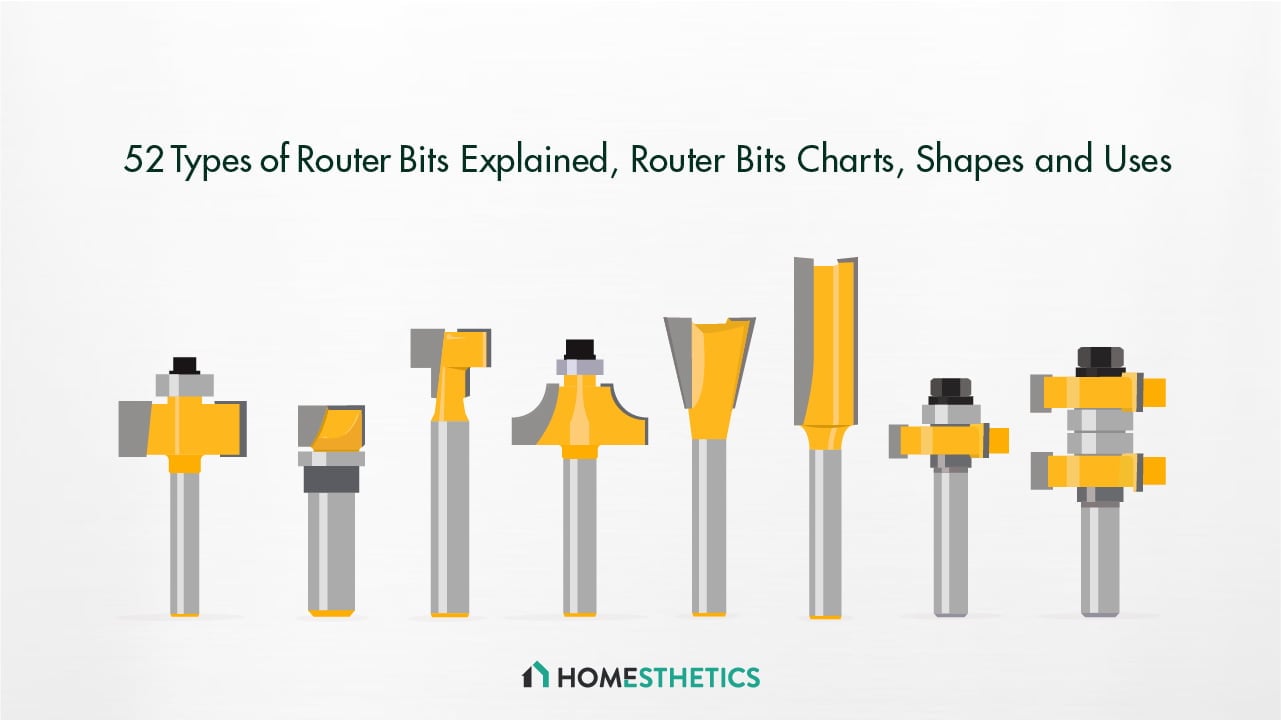
Router bits are cutting tools for woodworking, designed for use with routers. They come in various types and profiles for diverse tasks. Essential for shaping and detailing wood, with cutting edges of tungsten carbide, router bits are precision tools used by carpenters everywhere.
With a dazzling array of types, sizes, and profiles, these bits, from flush trim to chamfer, are the wizards of the woodworking universe. So, read my article to delve into the labyrinth of knowledge, discover the secrets of diameter and bearing, and unveil the wonders of cove, ogee, and rabbet.
Listed below are the most common types router bits:
- Straight bits: Straight bits are favored for smooth cuts in woodworking. They create edges and joinery in furniture and cabinets. The requirement to have different straight bits for various tasks is a limitation.
- Flush trim router bits: Flush trim router bits specialize in identical shapes and smooth edges, ideal for inlays and laminations. The need to swap bearings for varied profiles can be a disadvantage.
- Rabbeting router bit: The rabbeting router bit excels at creating grooves, enabling wood veneer or joinery insertion. It's less versatile compared to other bits.
- Chamfer bit: The chamfer bit can produce angled edges, crucial for decorative grooves and joinery. Its use is limited for tasks not needing angled cuts.
- Roundover router bit: Roundover router bit creates smooth, rounded edges on wood, with multiple radius options. The lack of suitability for intricate designs or unique profiles is a drawback.
1. Straight bits
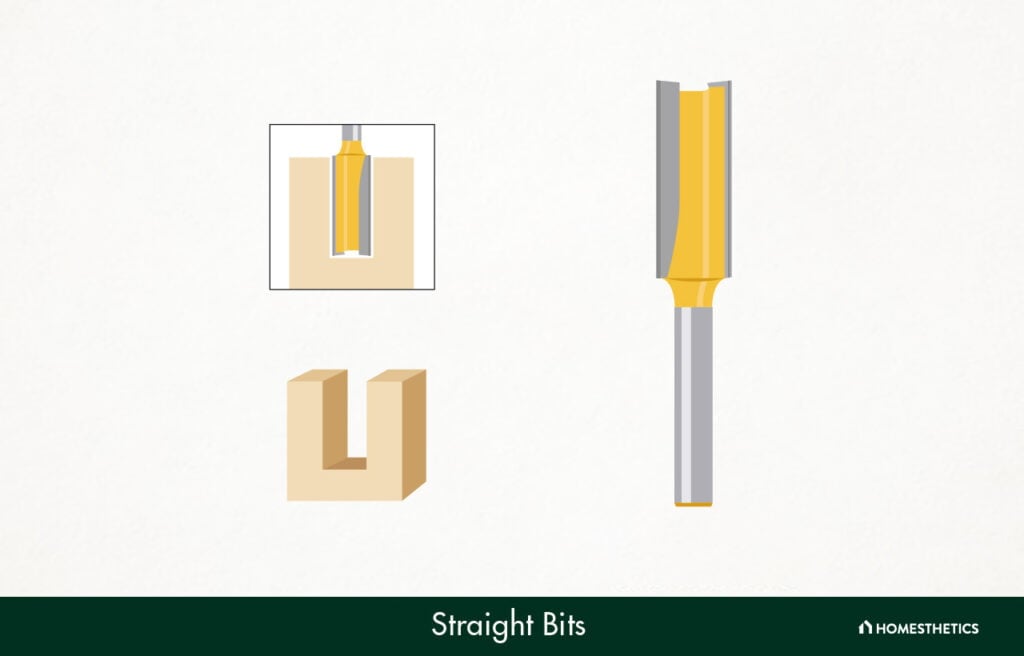
Straight bits are used in woodworking to create smooth, accurate cuts in wood and similar materials. They produce straight and decorative edges, similar to chamfers, coves, and beads. With different diameters and profiles, straight bits can create joinery, edges, and grooves for furniture, doors, cabinetry, and more.
2. Flush trim router bits
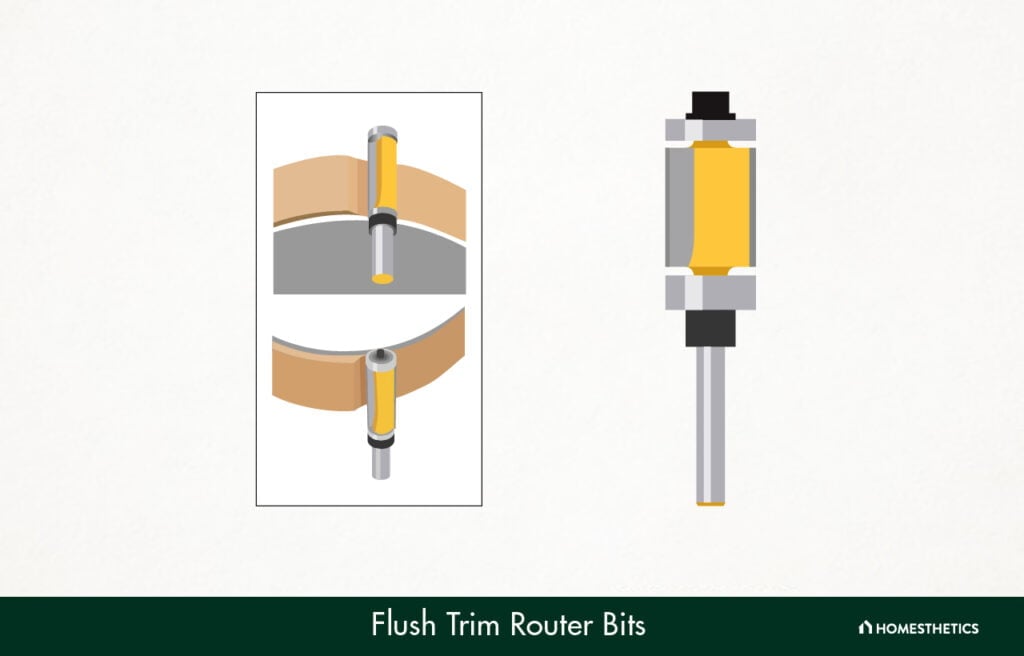
The flush trim router bit is a woodworking tool that creates smooth cuts and identical shapes on wood or similar materials. It features cutting edges of the same diameter, with interchangeable bearings for specific profiles. As such, it produces a flush, decorative edge, perfect for joinery, laminations, inlays, and edge forming.
3. Rabbeting router bit
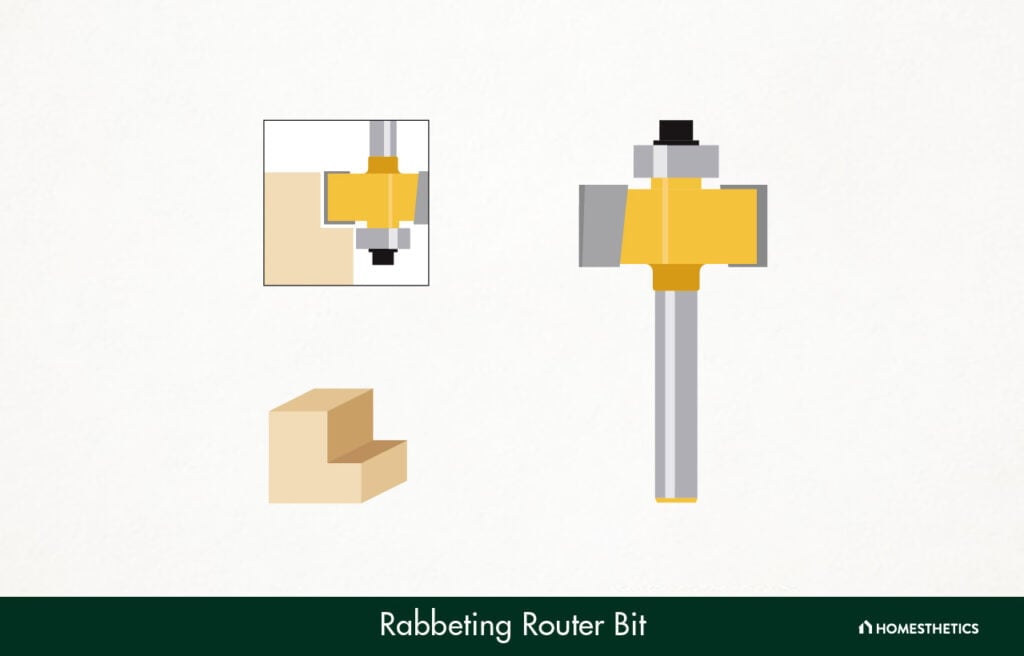
It is used to create a groove or rebate in a workpiece. Drawing from experience, it forms a right-angle cut along the edge, allowing for the insertion of other pieces, such as wood veneer or joinery elements like a tongue and groove or dado.
4. Chamfer bit
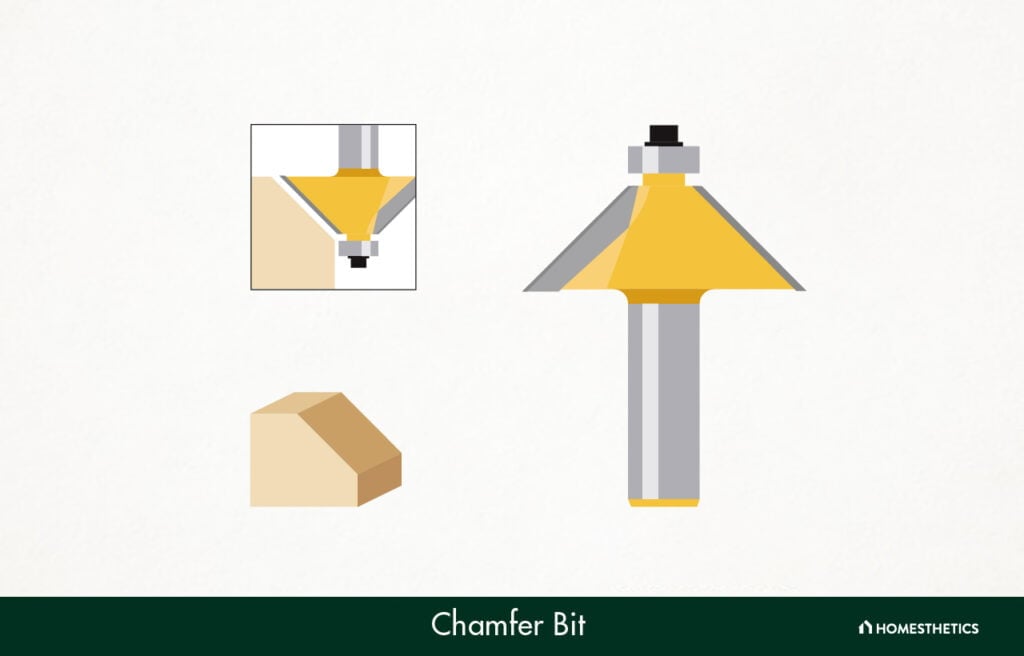
A chamfer bit is used to create beveled or angled edges on various materials. The shape of the bit is like a curved edge, and it is often equipped with carbide tips for fast cutting. It is used in woodworking and construction to produce decorative grooves, joinery, and edge cuts.
5. Roundover router bit
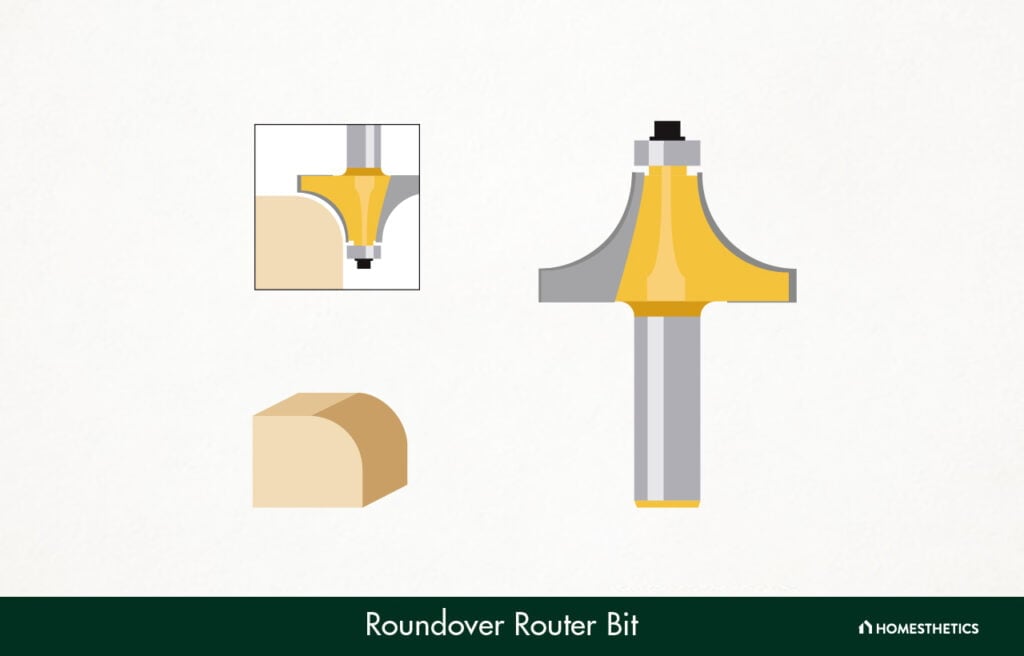
Roundover bits are used to create a curved profile on the edge of the wood, producing a smooth, rounded shape. My findings show that they are commonly used for decorative purposes and can be sized with different radius options. Additionally, the bit is made of carbide-tipped steel with a spiral design and is often used with a router table or handheld router.
6. Cove router bit
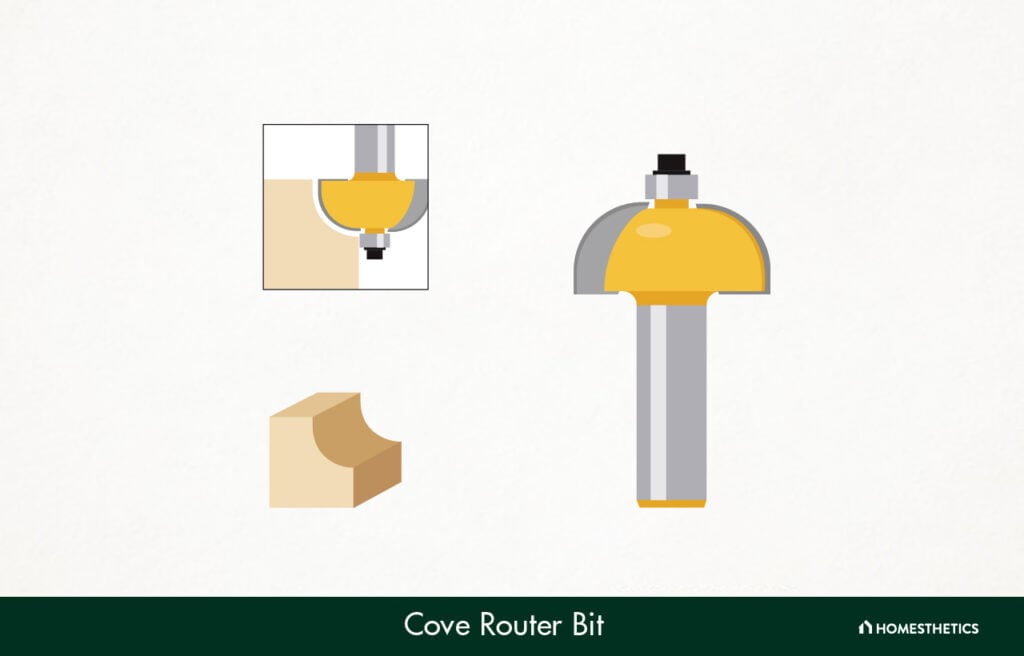
Cove bits create concave cuts and profiles in wood and similar materials. They produce a curved shape, commonly used for edge forming, picture frames, and molding. Cove bits come in different sizes and are often used with a table-mounted router featuring a guide bearing for precise cutting at a specific depth.
7. Roman ogee bit
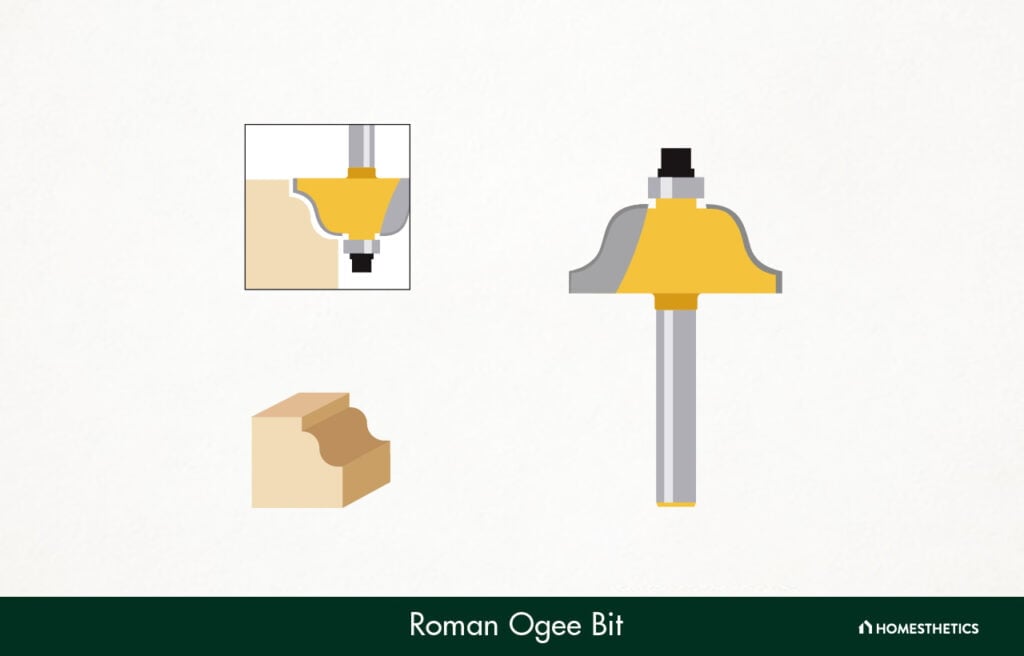
The Roman ogee bit is commonly used in woodworking and creates a decorative profile with a bead followed by a concave cove. It’s sized for edge forming, like crown molding or baseboard, and can engrave patterns.
8. Beading router bit

A beading router bit, used for edge forming, creates decorative rounded grooves on wood or similar materials. It produces a bead contour-shaped edge, with a pilot bearing guiding the cut. Among a huge variety of router bit profiles, this bit is commonly used to create a woodworking joint, such as the dovetail joint, mortise, and tenon, or miter joint, for crafting furniture, cabinets, or window frames.
9. V-groove router bit
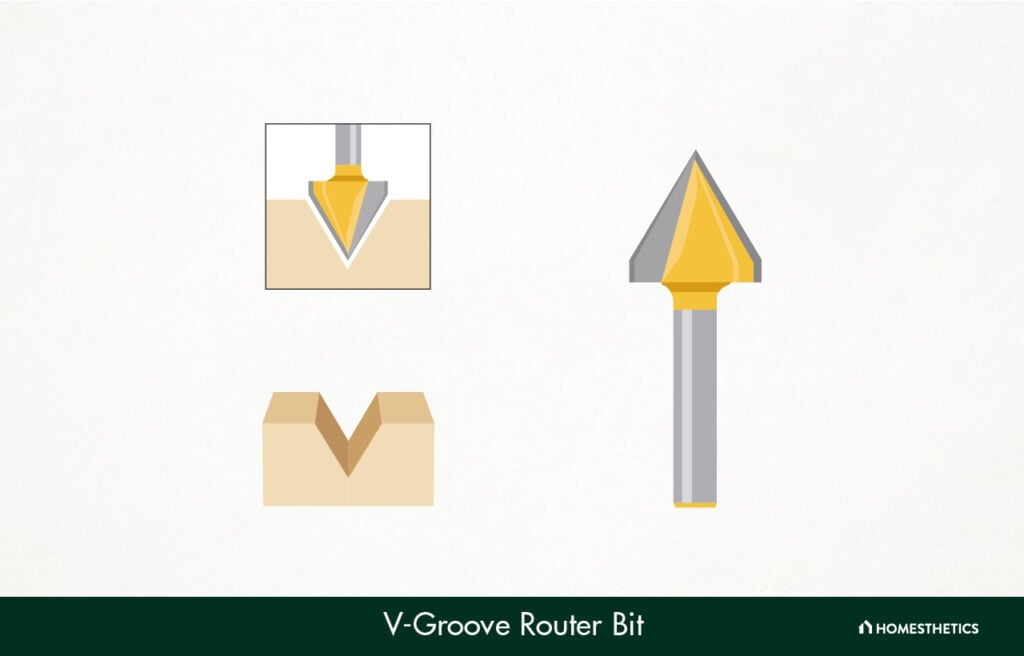
A V-groove router bit, specifically designed for edge forming, is commonly used to create a V-shaped groove on lumber, laminations, or similar objects. The carbide-tipped bits with sized bearings produce a bevel shape at the top edge, suitable for joinery, engraving, or fluting tasks.
10. Dovetail router bit
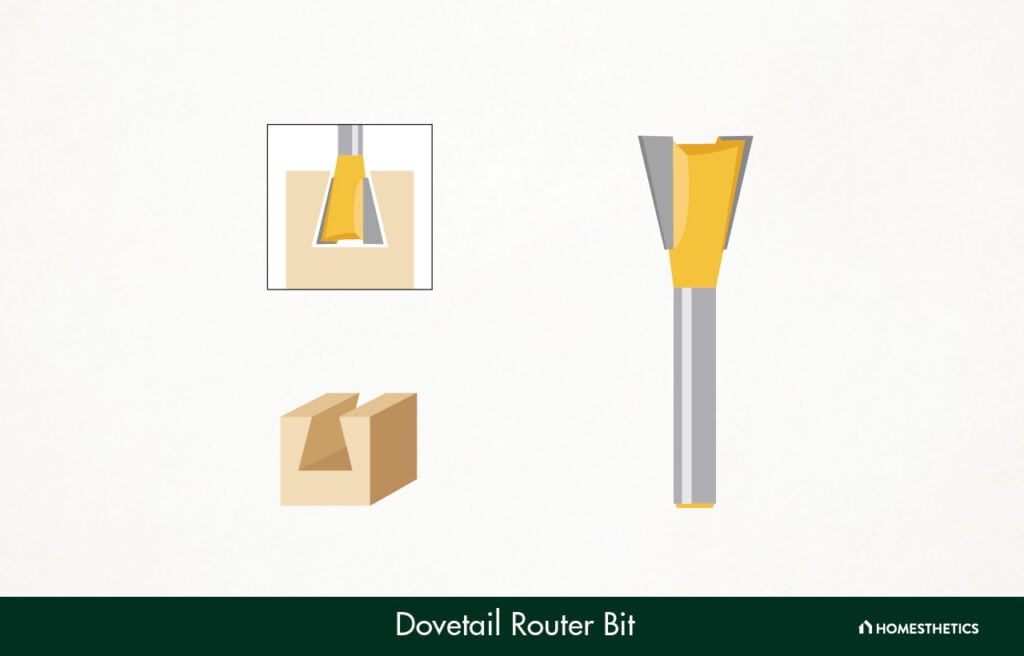
It is used to create dovetail joints in woodworking. My research indicates that it cuts angled slots in the wood, allowing a tight interlocking connection between two pieces. The shape of the bit resembles a beveled edge, producing strong and aesthetically pleasing joints. It is used for drawer construction, stile and rail assembly, and countertop edges.
11. Edge forming bits
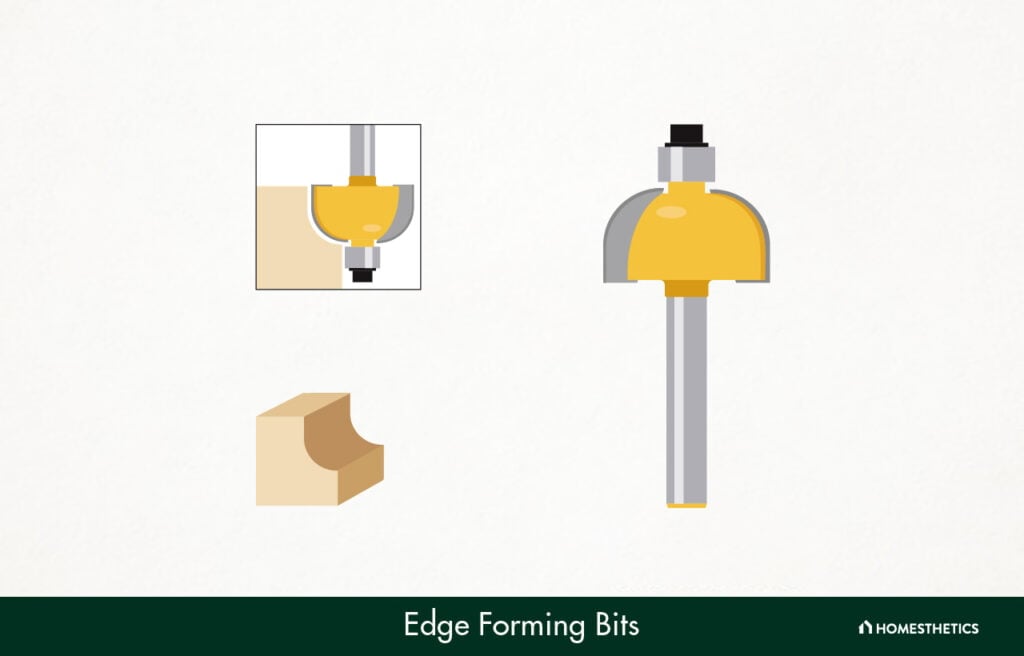
Edge-forming bits shape and profile the edges of wood and acrylic materials. They create decorative profiles, chamfers, or roundovers and can be used with various wood router bit shanks and other types of routers. The depth of cut, speed, and wood grain affect the final result.
12. Ogee router bit
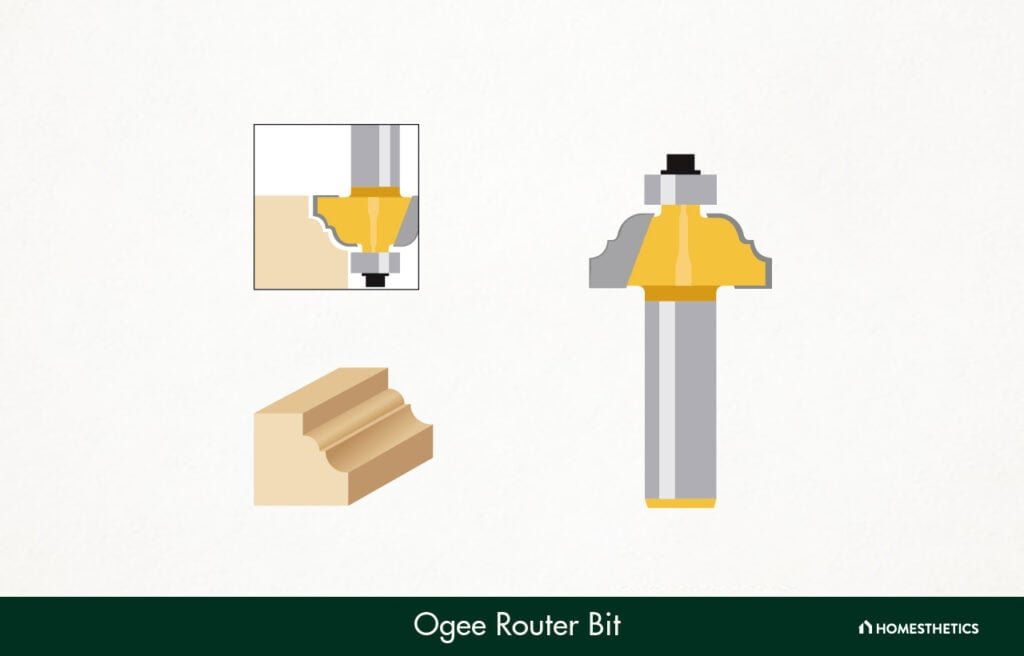
The ogee bit, a type of edge-forming bit, carves wood with its spiral shape. It creates decorative profiles and is commonly used in joinery. It’s ideal for crafting finger and rule joints, allowing strong connections without relying on screws or adhesive.
13. Cove box router bit
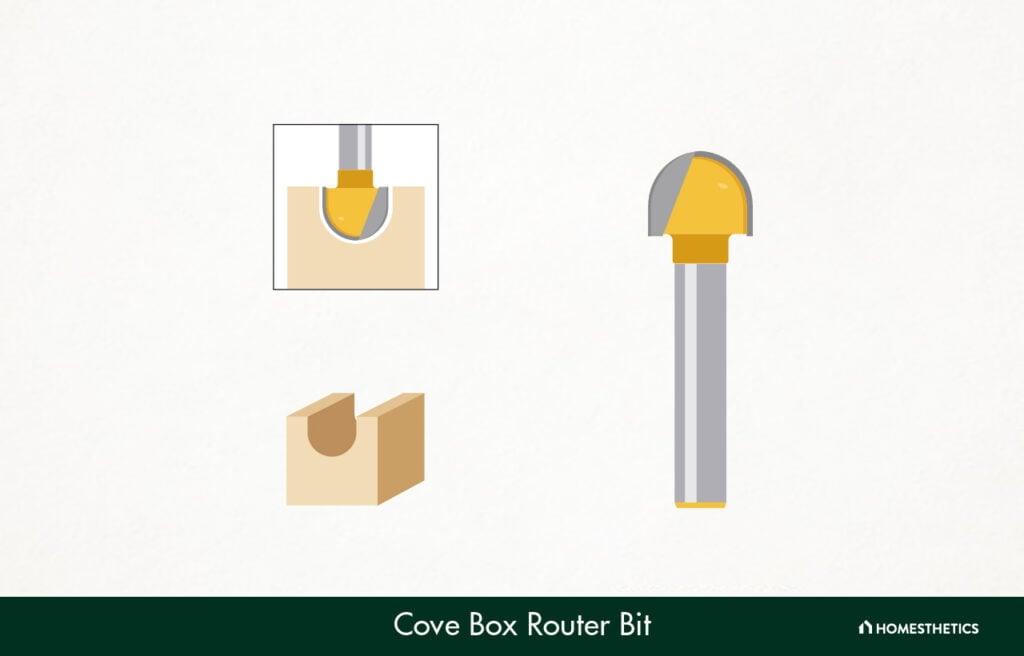
A cove box router bit creates a concave groove or channel in wood. It’s compatible with various wood router types and features a semi-circular design on the bit shank, ideal for carving wood and producing precise glue joints. No hinge, screw, or edging bit is required.
14. Cove and bead router bit
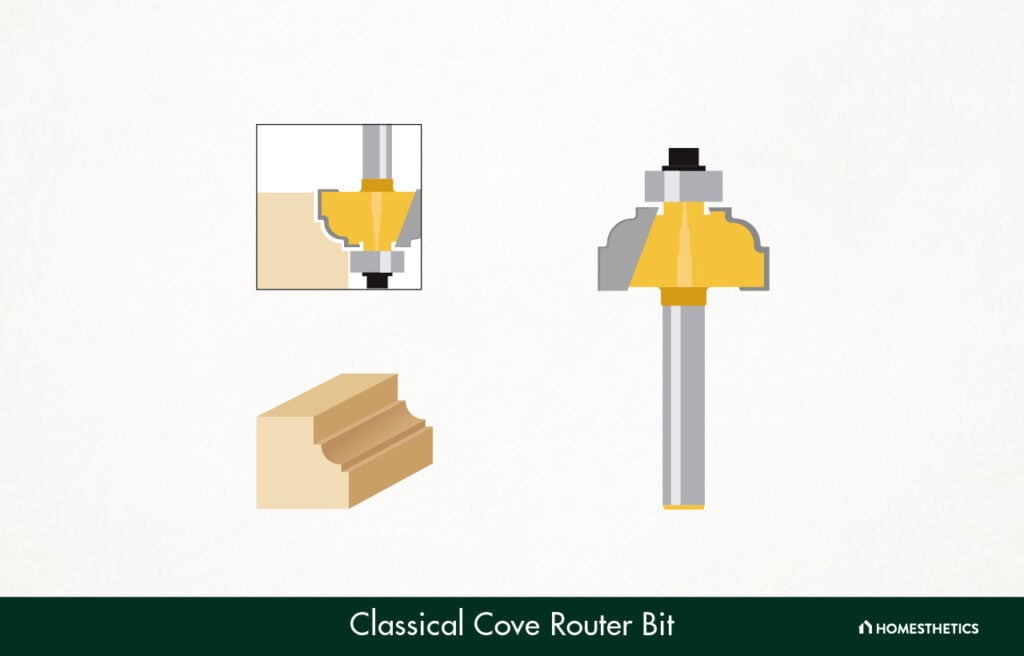
This is another type of edge-forming bit that creates concave grooves or decorative profiles on the edges of wood. It is commonly used in joinery and features a spiral design on its shank.
15. Bullnose router bit
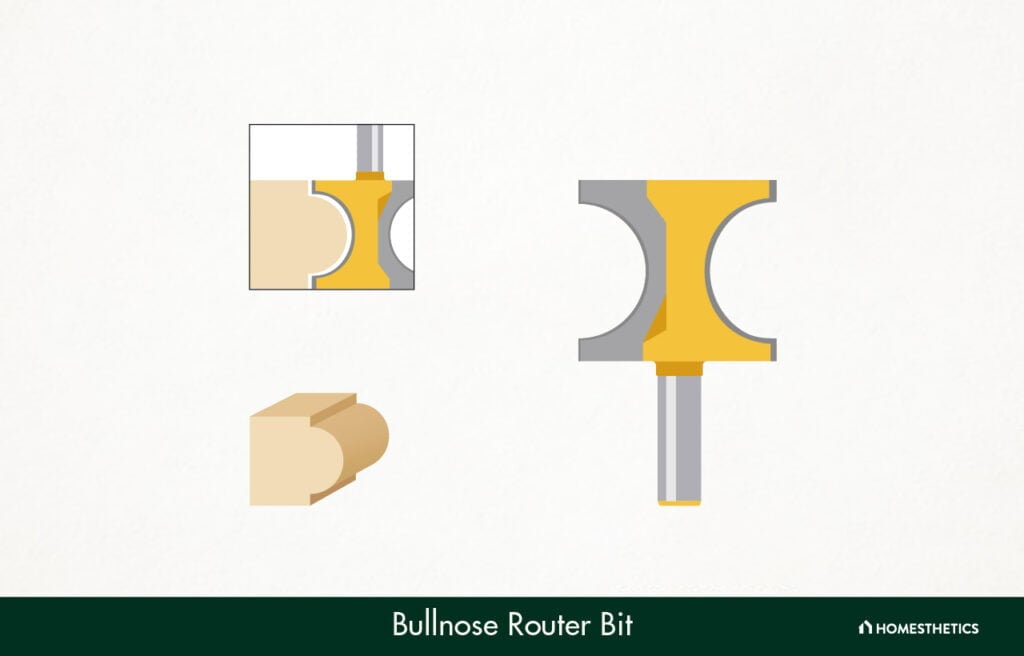
A bullnose router bit, used with a router bit shank, creates a rounded profile on the edge of a workpiece. It falls under the category of joinery bits and is ideal for adding smooth, decorative finishes to woodworking projects.
16. Bevel router bit
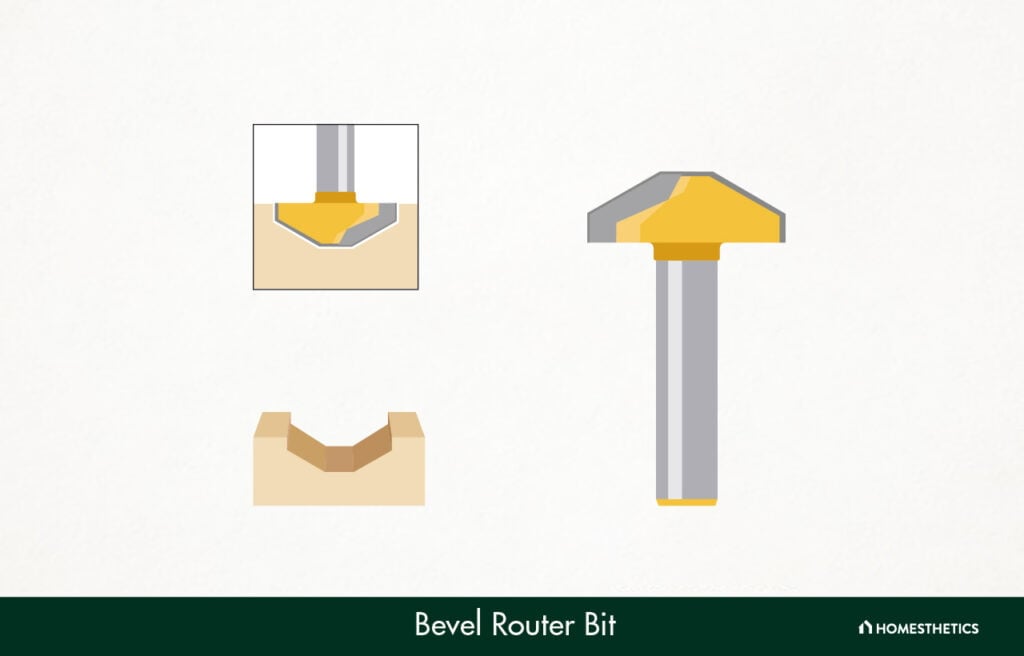
A bevel router bit creates a chamfered edge or beveled profile on a workpiece. It features a sloping cutting edge that smoothly removes material, resulting in a clean and angled shape. Unlike spiral bits, bevel router bits specialize in producing beveled edges.
17. Ovolo router bit
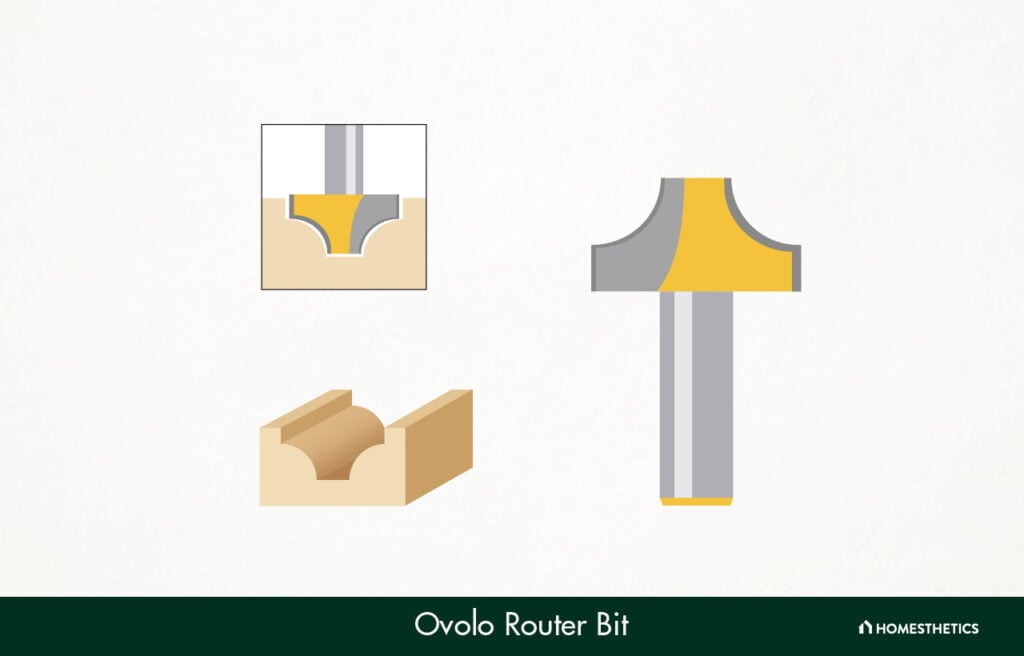
This bit type is used to create a classic and decorative profile on woodworking projects. It produces a convex shape with a rounded edge, adding an elegant and smooth finish to the edges of various materials, such as wood or plastic.
18. Keyhole router bit
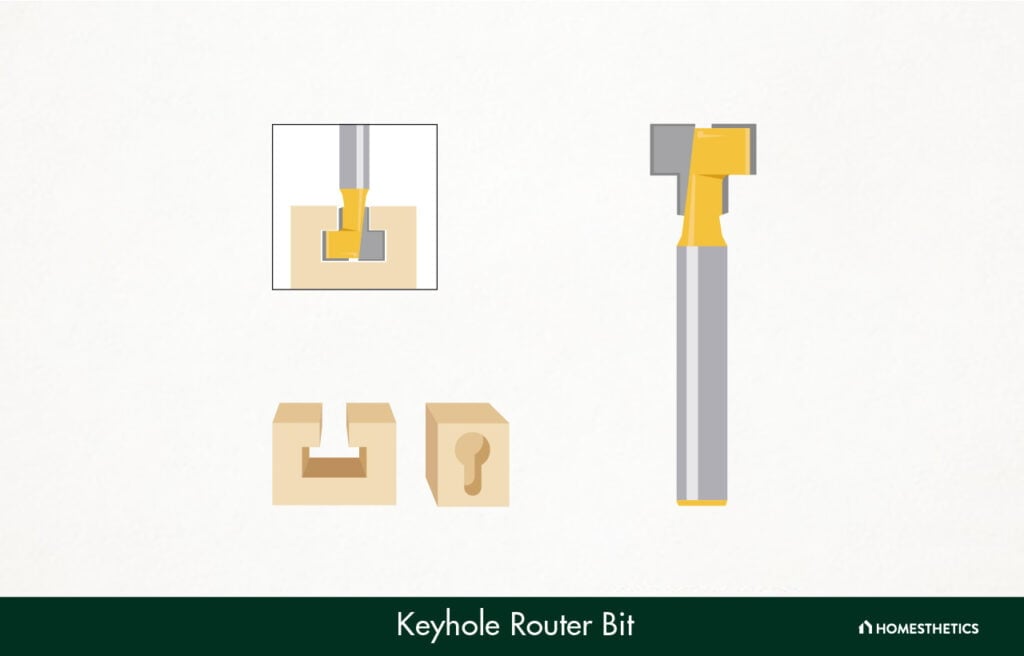
It features a cylindrical body with a wide, flat-bottomed groove and a narrow, tapered end. This bit can produce a keyhole-shaped slot in wood or plastic, which allows for hanging items on a wall or mounting them securely.
19. Multi-profile router bit
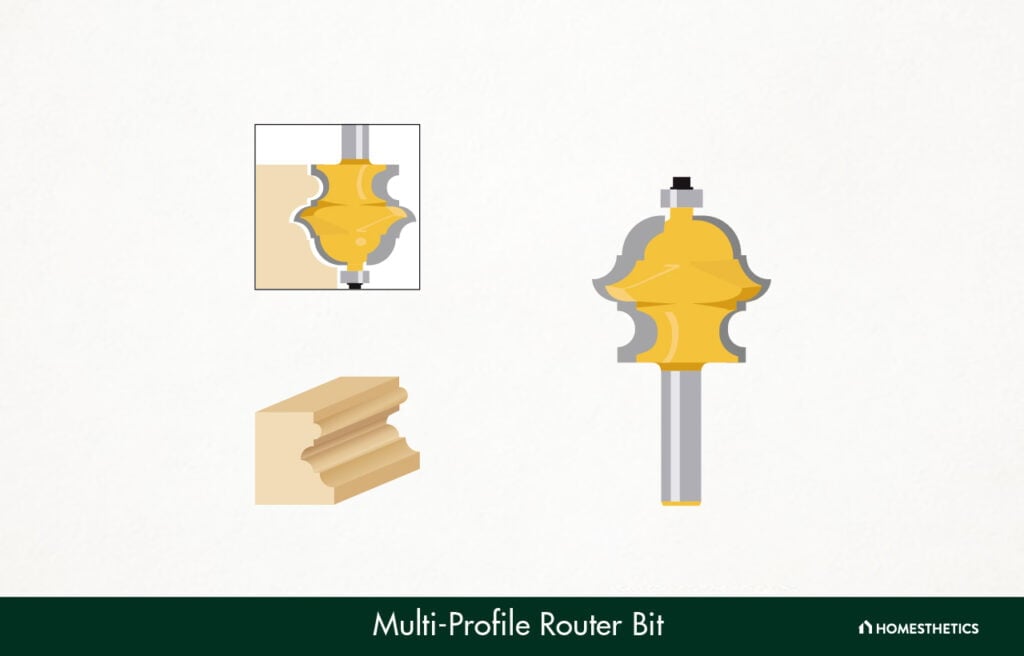
This is a versatile bit type used in woodworking, featuring multiple cutting edges, allowing it to create various decorative profiles on the edges of wooden boards. It produces intricate shapes, such as ogees, coves, beads, and rounds, adding detail and elegance to the finished woodworking project.
20. Slot cutter router bit
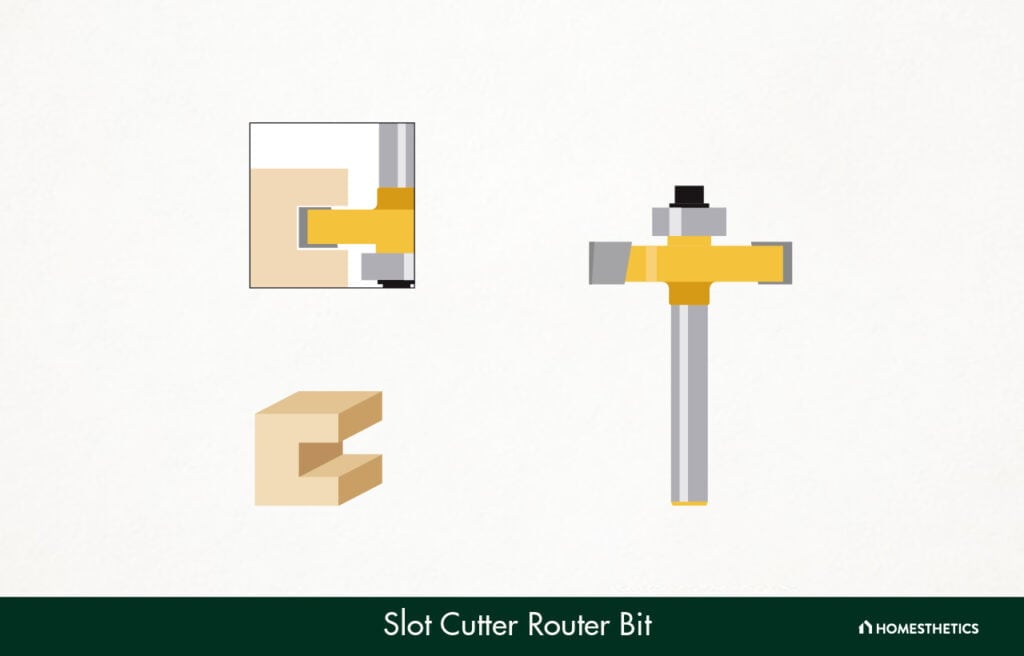
It is used to create grooves or slots in wood or other materials. The bit features a cylindrical shape with sharp edges that cut precise slots, allowing for the insertion of items like splines, biscuits, or T-molding, enhancing joint strength and decorative design possibilities.
21. Panel pilot router bit
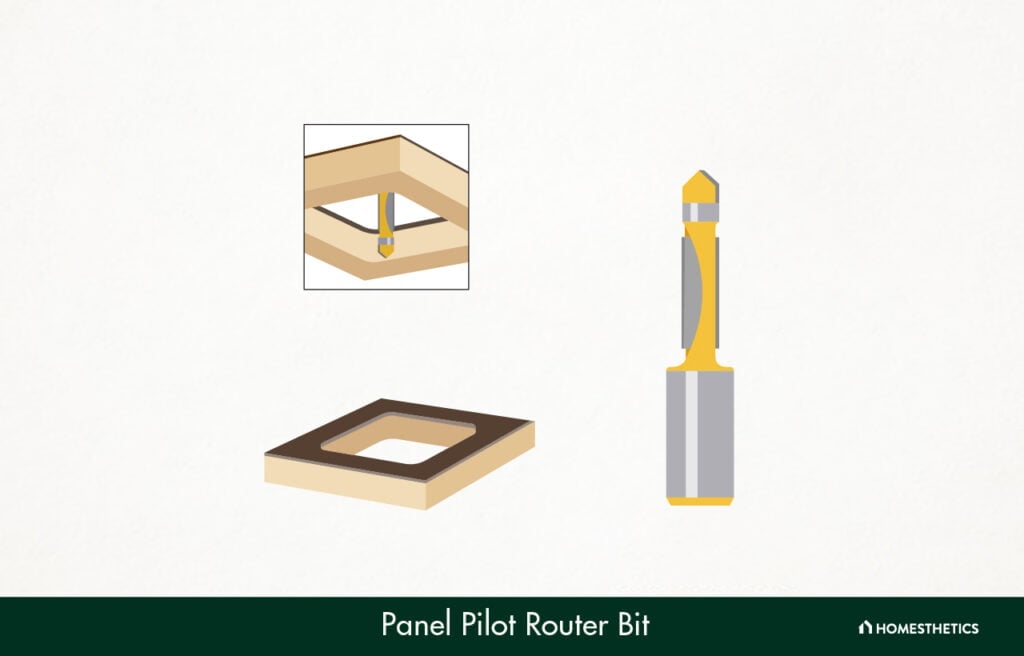
Panel pilot bits are designed to trim and shape panels. They produce a smooth, clean-cut edge on materials like plywood, melamine, or MDF. They feature a pilot bearing that follows a template, allowing for precise and consistent trimming, resulting in professional-looking panel edges.
22. Raised panel router bit
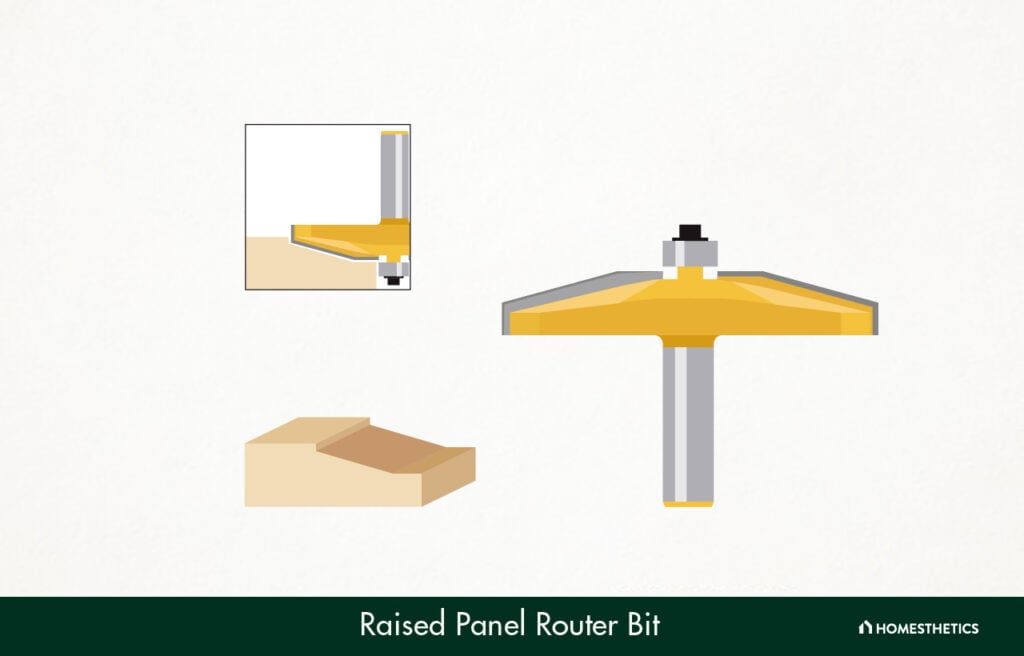
These router bits shape the edge of a panel, creating a decorative profile. They feature a cutter with a convex shape that cuts the wood, resulting in a raised panel with a stylish and traditional look.
23. Fluting bits
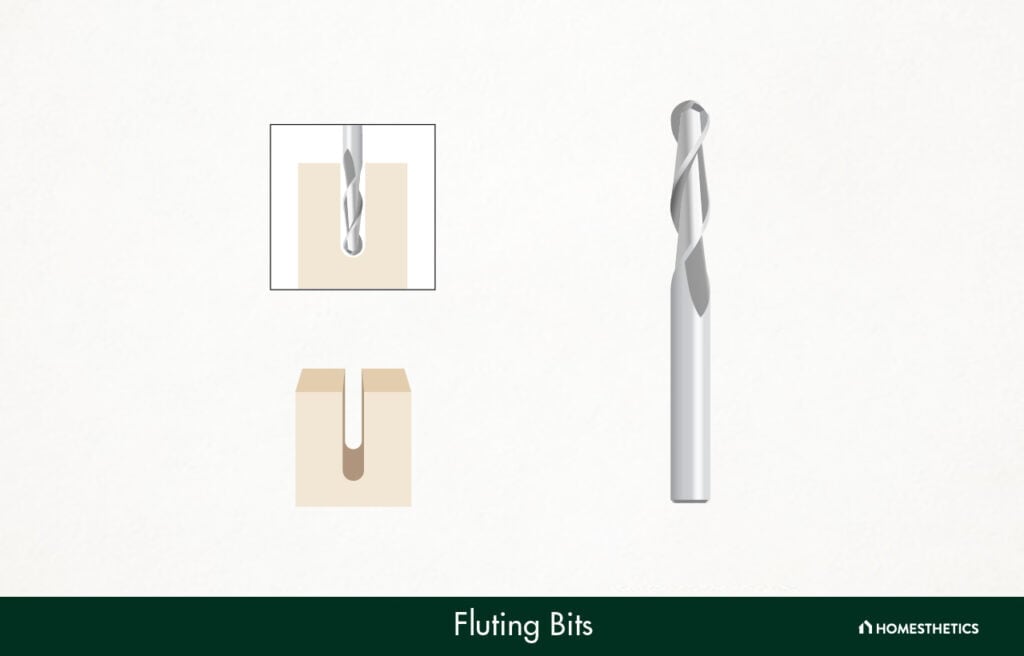
A fluting router bit is used to create gloves or flutes in woodworking projects. It features multiple cutting edges that cut evenly spaced channels into the material, resulting in decorative or functional designs, such as fluted columns, moldings, or panels.
24. Molding router bit
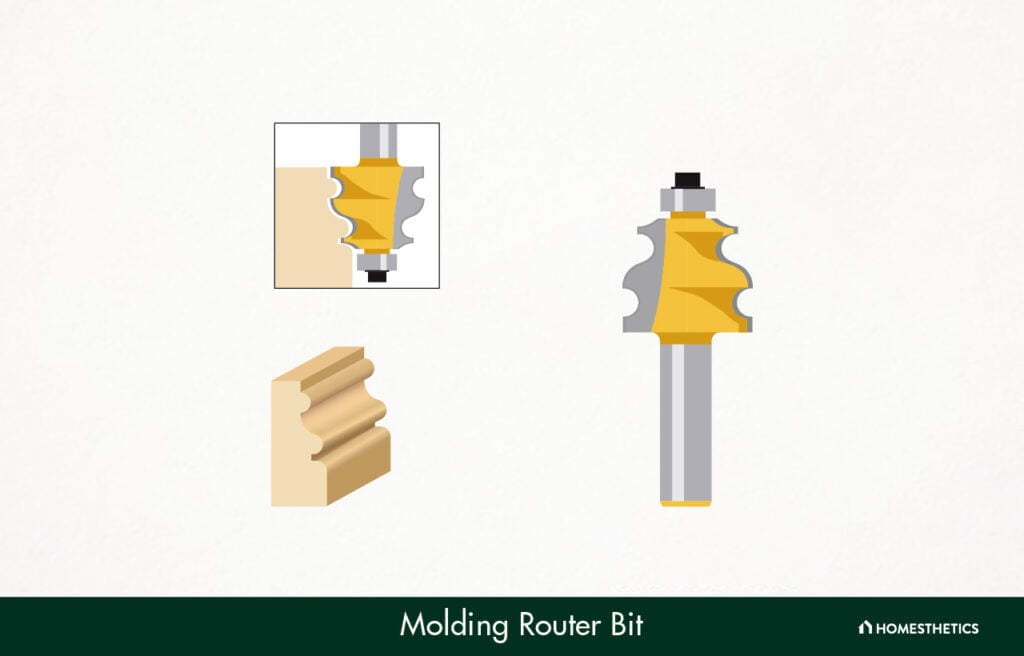
It is used to shape and create decorative moldings on wooden surfaces. The bit features a profiled cutting edge that produces intricate designs, such as ogee, cove, or bead shapes when passed along the edge or surface of the wood.
25. Picture frame router bit
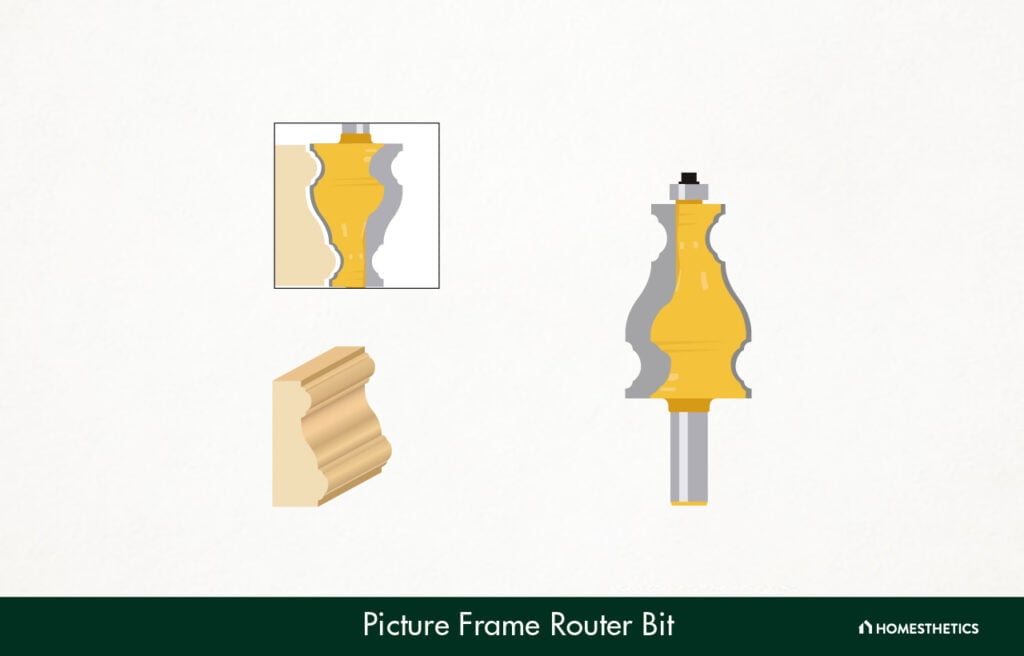
A picture frame router bit is used to create decorative profiles on the edges of picture frames. It produces a precise and uniform shape, typically featuring intricate patterns or beveled edges, enhancing the overall aesthetic appeal of the frame.
26. Tongue and groove router bit
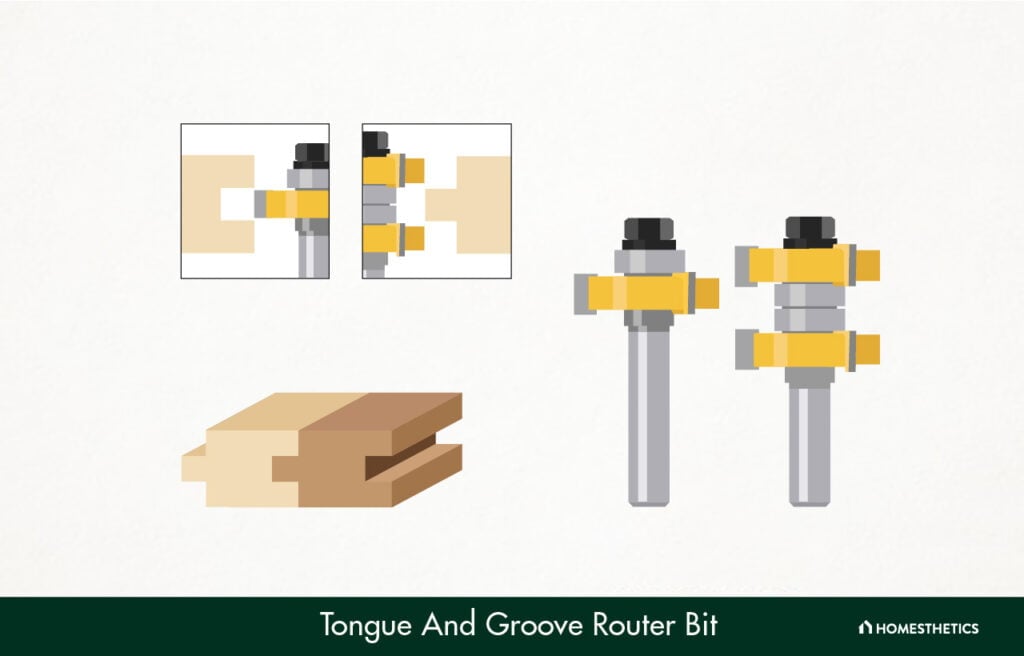
A tongue and groove router bit creates a strong joint between two pieces of wood. It produces a tongue-shaped projection on one end of the wood and a corresponding groove on the other edge. This allows for precise fitting and alignment when joining the pieces together.
27. Rosette router bit
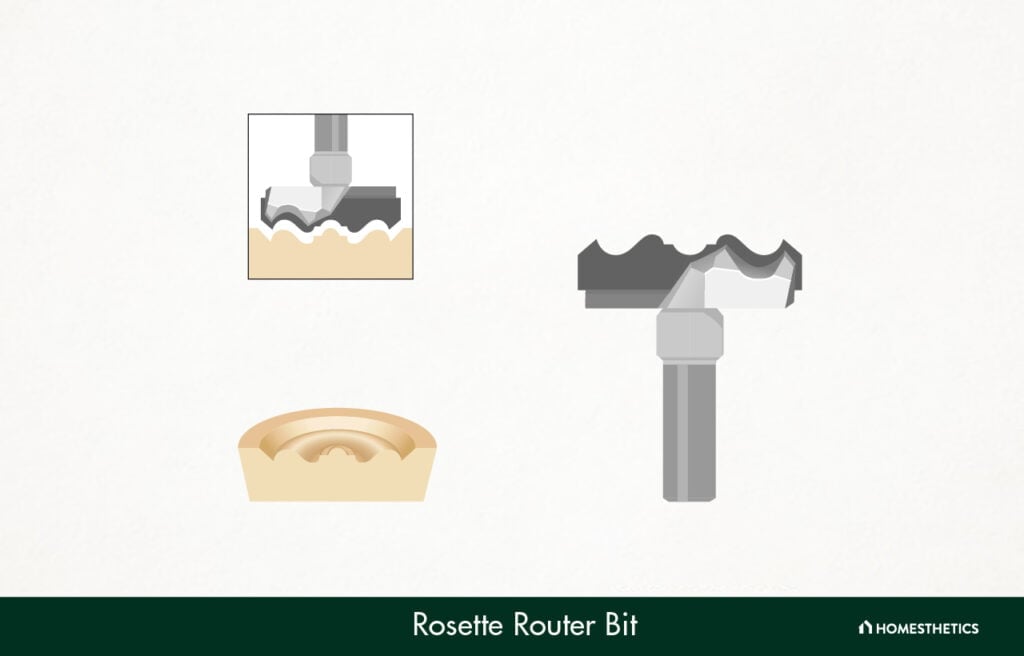
The bit is used in woodworking to create decorative rosette shapes. It has a cylindrical body with cutting edges on its circumference. When used with a router, it produces circular recesses or rosette patterns on wooden surfaces adding ornamental details to furniture, moldings, or architectural elements.
28. Vase router bit
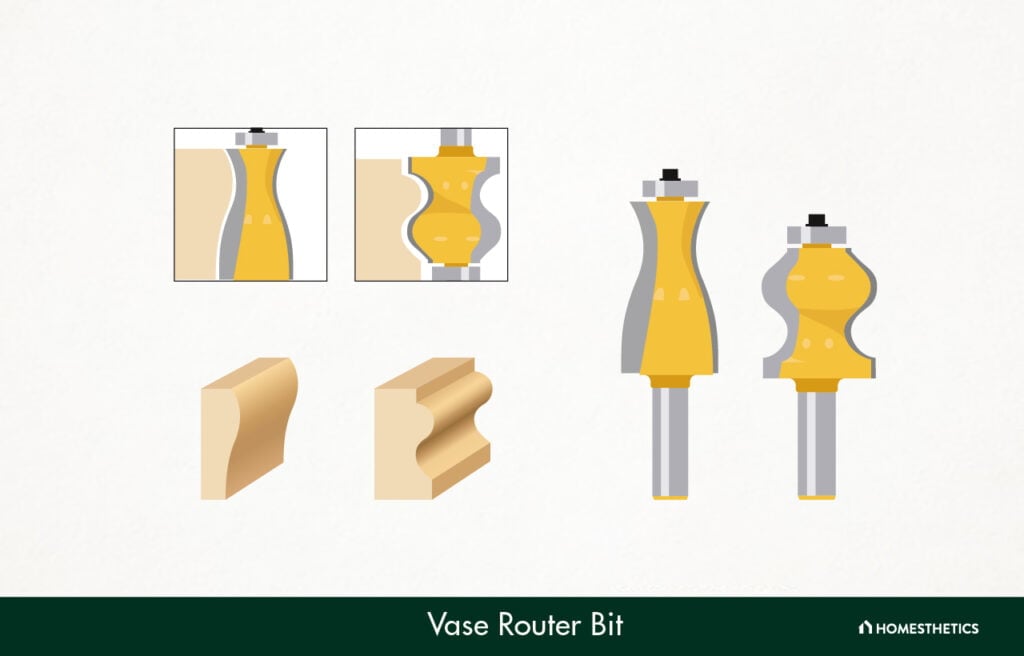
A vase router bit is used in woodworking to create decorative wooden designs on the surface of a wooden vase. It produces a series of evenly spaced grooves or flutes that add texture and visual interest to the vase, enhancing its aesthetic appeal.
29. Ballnose router bit
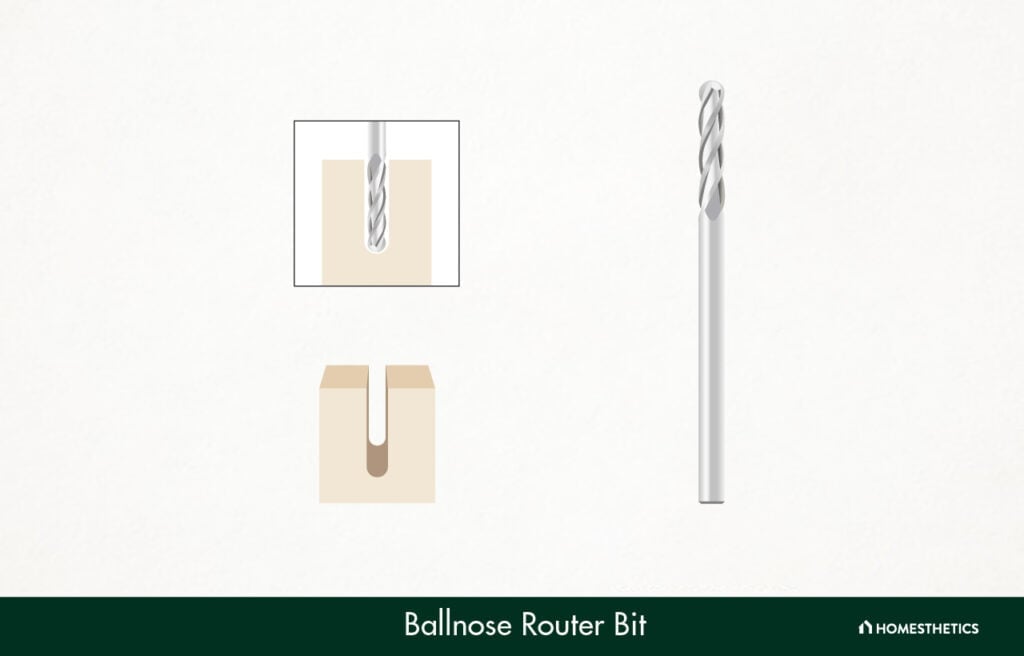
It is used in woodworking and machining to create curved, rounded edges or contours on various materials. It has a spherical-shaped cutting tip that produces smooth, rounded profiles, adding a decorative or functional touch to the workpiece.
30. T-slot router bit
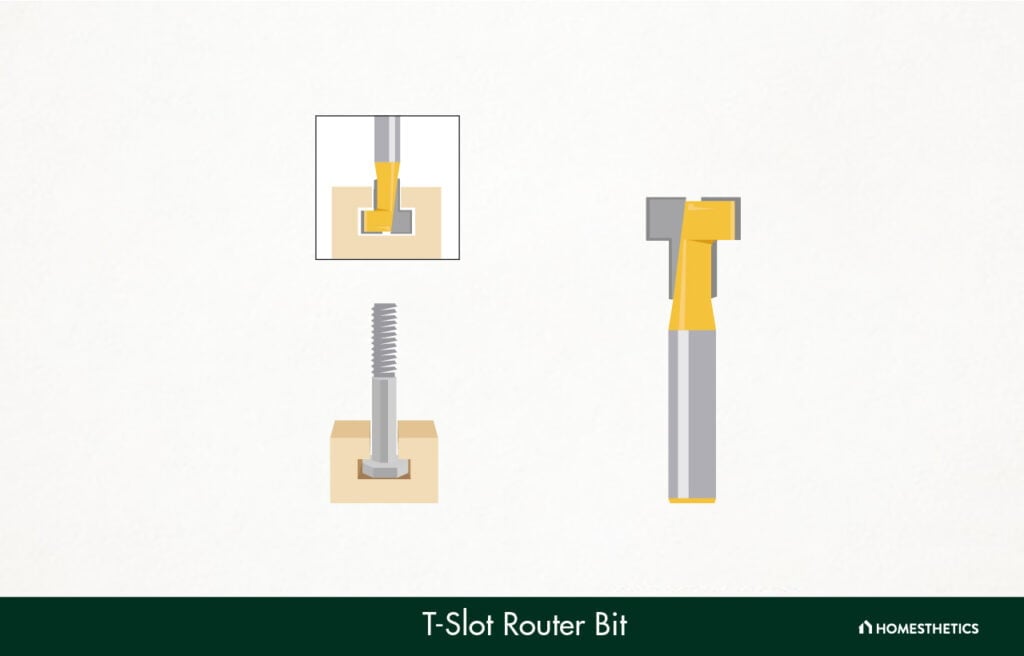
A T-slot router bit is used to create T-shaped slots or grooves in materials, such as wood or metal. It features a cutting-edge shape like a T, allowing for the precise formation of slots to accommodate T-shaped connectors or accessories.
31. Mortising router bit
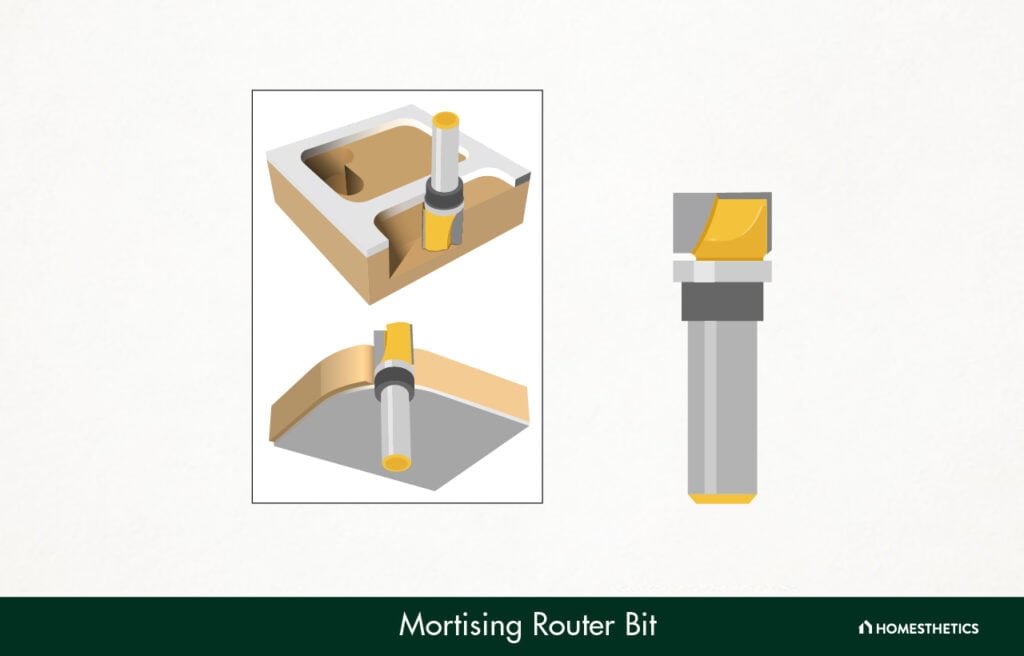
Mortising router bits create rectangular or square-shaped holes in woodworking projects. They attach to a router and cut precise, clean slots, ideal for mortise and tenon joints. The design of the bit allows for efficient waste removal, resulting in accurate and professional-looking joints.
32. Stair tread router bit

A stair tread router bit is used to shape stair treads, typically made of wood. It features a curved profile with a bullnose edge that creates a smooth, rounded shape on the front edge of the tread, enhancing safety and aesthetics by eliminating sharp corners and edges.
33. Sign-making router bit
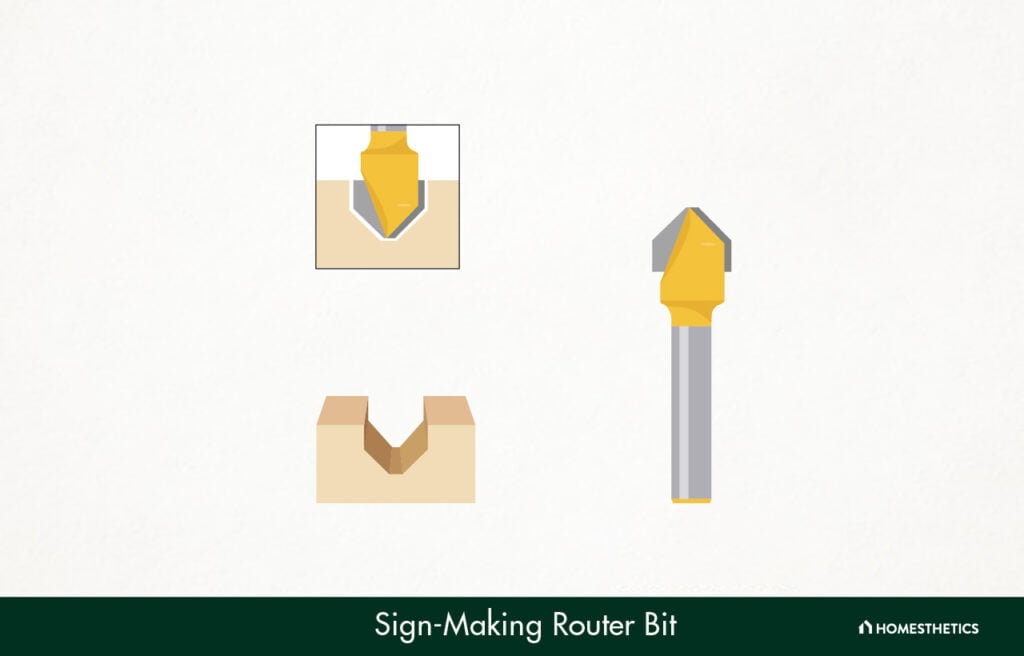
A sign-making router bit is used to carve special letters and designs on signboards. It typically features a V-shaped tip that creates clean and defined grooves when guided along the material. This produces professional-looking, engraved lettering and decorative patterns for signs and plaques.
34. Engraving router bit
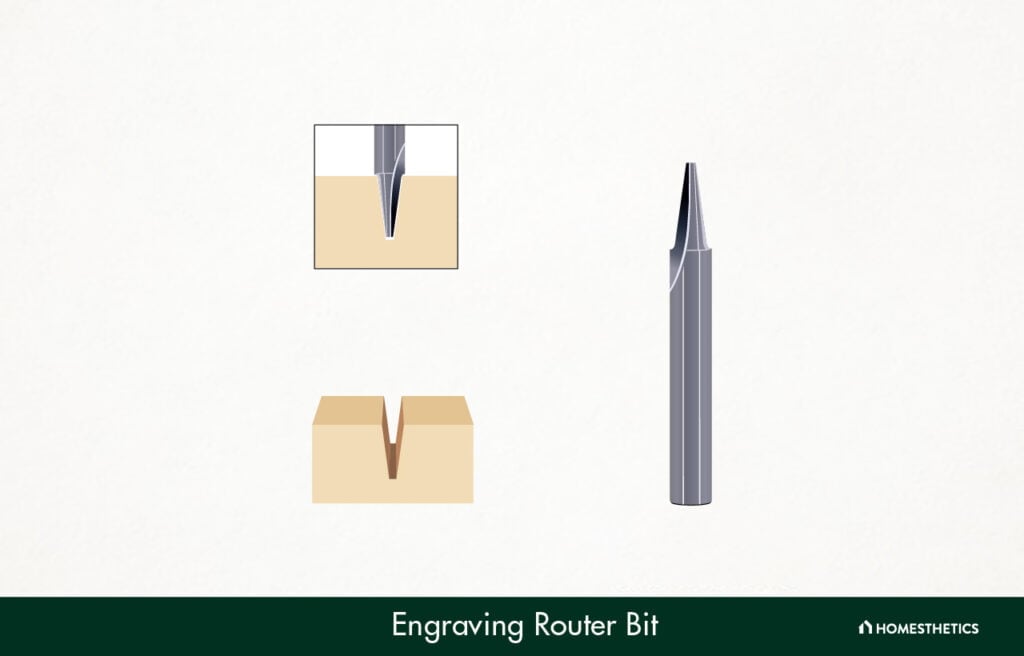
It produces shallow, precise cuts on materials such as wood or plastic, resulting in decorative shapes, text, or graphics.
35. Inlay router bit

An inlay router bit helps create recessed areas in wood or other materials. It produces a flat-bottomed groove with straight sides, allowing for the insertion of decorative inlays or joinery elements, enhancing the overall aesthetic appeal of the finished product.
36. Bowl and tray router bits
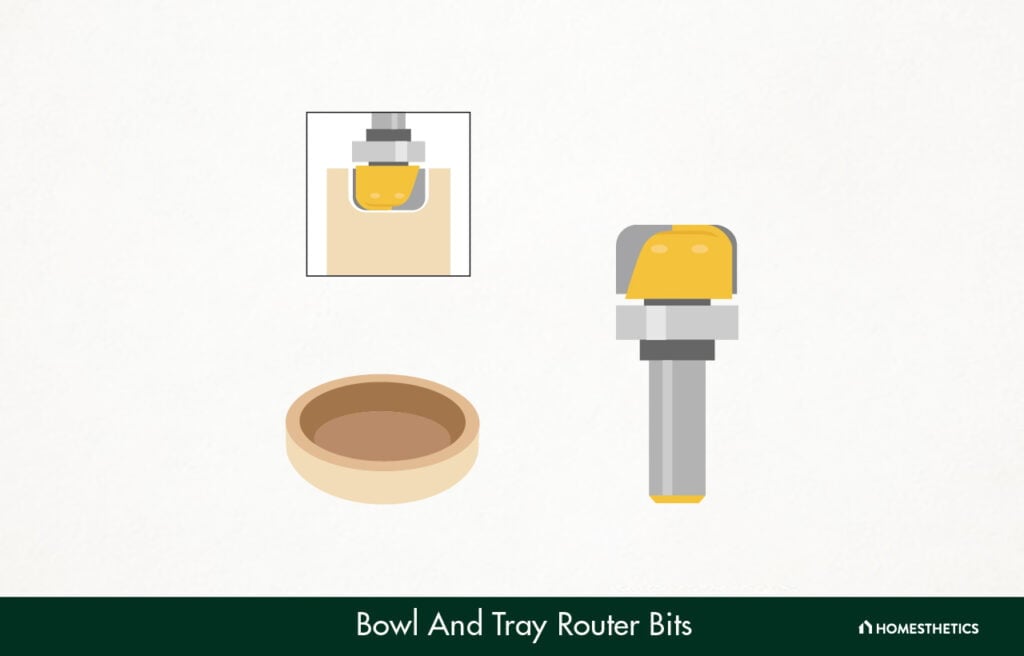
They can create concave or hollow shapes in wood. The bit features a curved cutting edge that removes material, resulting in bowls, trays, or recessed areas. The design of the bit allows for smooth, precise cuts, making it ideal for woodworking projects requiring curved or rounded surfaces.
37. Double roundover router bit
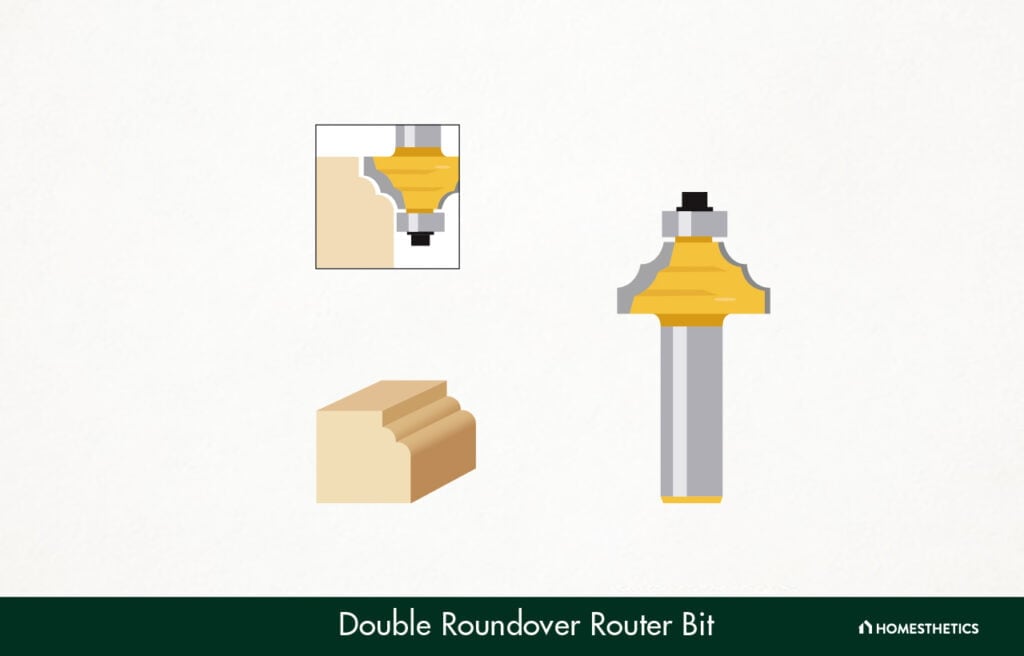
A double round-over router bit helps create a smooth, rounded edge on wood or other materials. It features two cutting edges that create symmetrically curved profiles on both the top and bottom of the workpiece, resulting in a decorative, double-rounded shape.
38. Table edge router bits
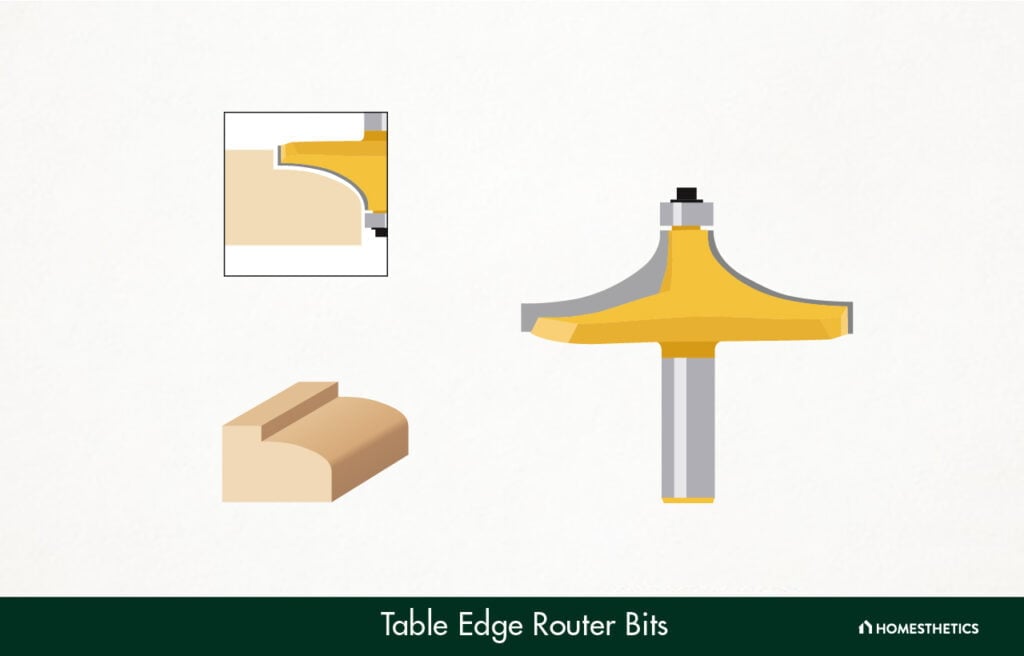
The bit is used to shape the edges of wooden tabletops and other surfaces. It creates a decorative profile along the edge, such as a roundover, beading, or ogee shape, enhancing the appearance and providing a smooth, finished look to the furniture piece.
39. Butterfly spline router bits
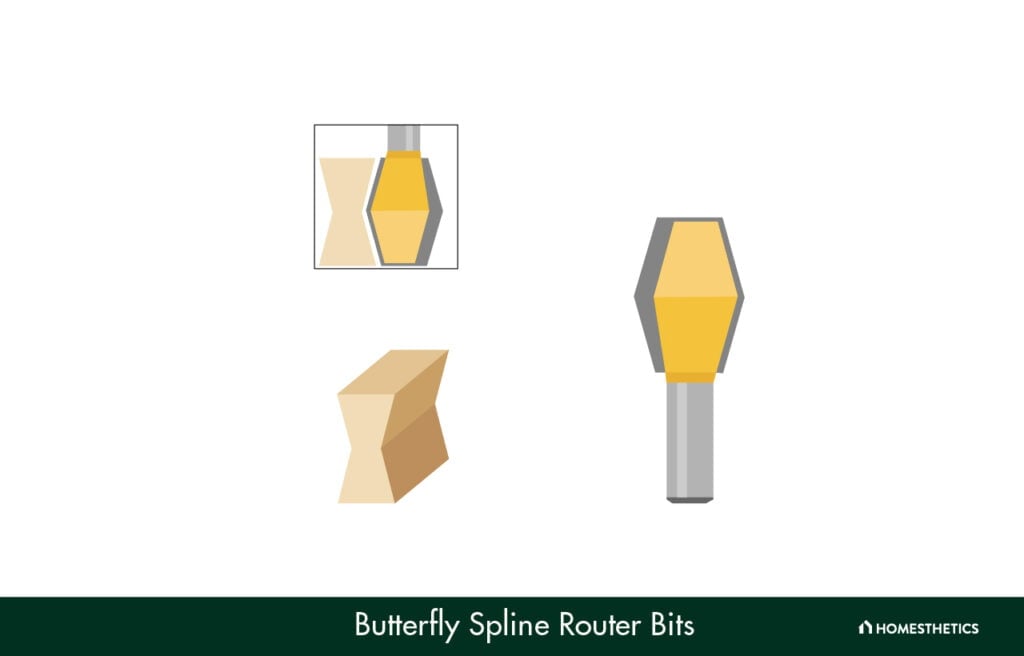
It can create decorative butterfly-shaped inlays in woodworking. The bit cuts a narrow groove in the wood, and when paired with matching splines, it forms an attractive butterfly pattern, adding both strength and beauty to joints.
40. Half-round router bits
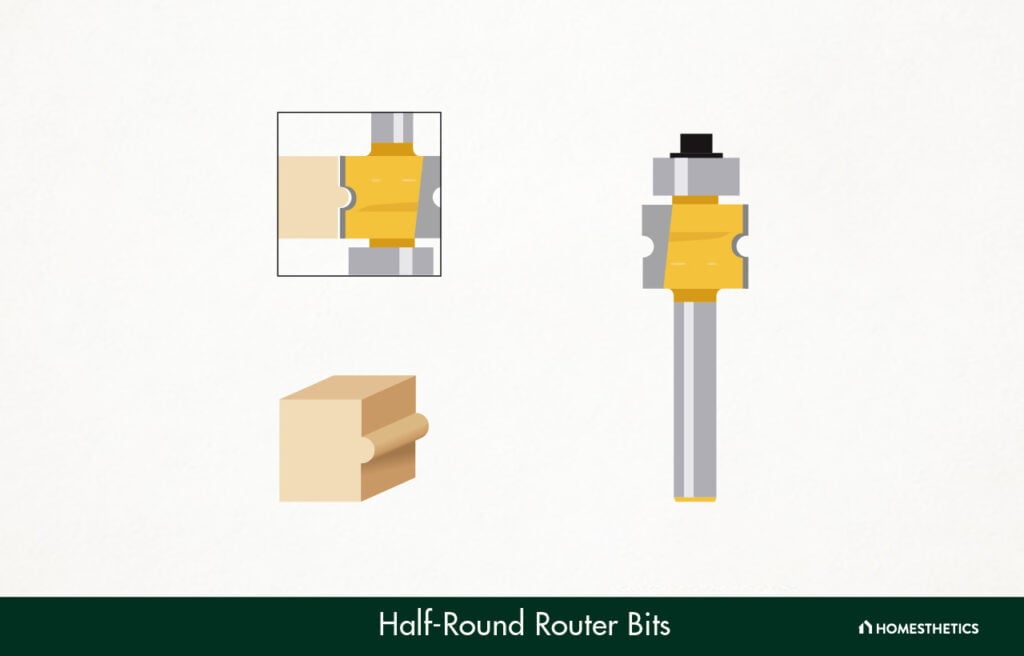
A half-round router bit helps create a semi-circular groove or decorative edge design on wooden surfaces. This bit is used in woodworking projects to add elegance and dimension. It features a rounded cutting edge that removes material, resulting in a smooth, symmetrical half-round shape.
41. Slatwall router bits

A slatwall router bit can help create slatwall panels with grooves or slots for displaying merchandise. It features a straight cutting edge that forms uniformly spaced channels upon usage. These channels allow hooks, brackets, and shelves to be easily inserted, providing a versatile and adjustable display system for retail environments.
42. Tapered ballnose router bits
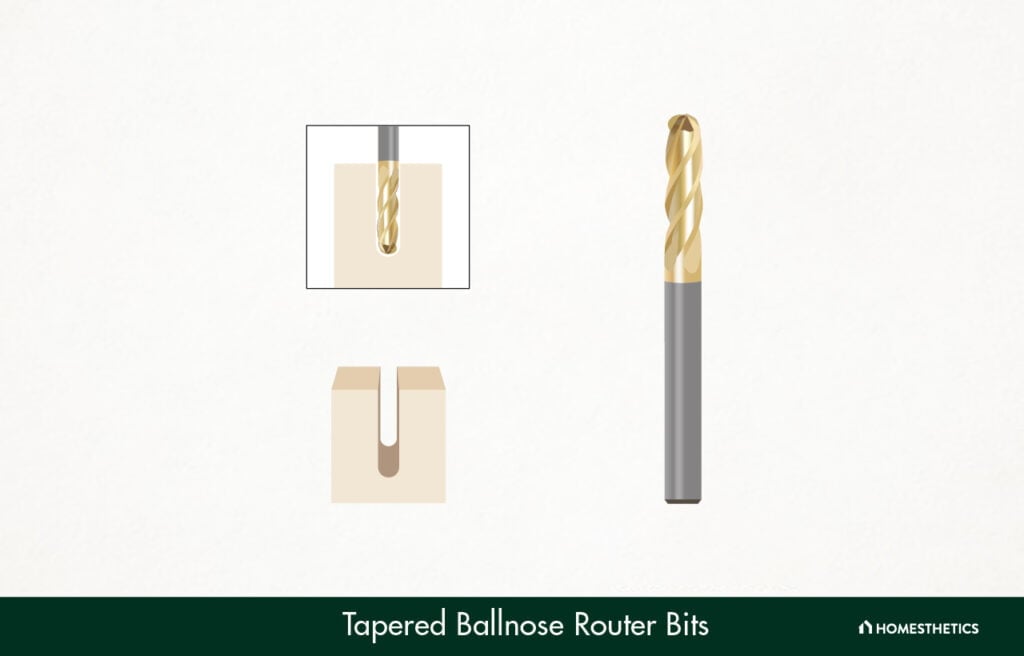
This bit is used in woodworking and machining to create intricate curved or rounded profiles. It features a tapered shape with a rounded tip, allowing for smooth and precise cutting in tight spaces. Moreover, it produces concave and convex shapes with smooth transitions.
43. Corner rounding router bits
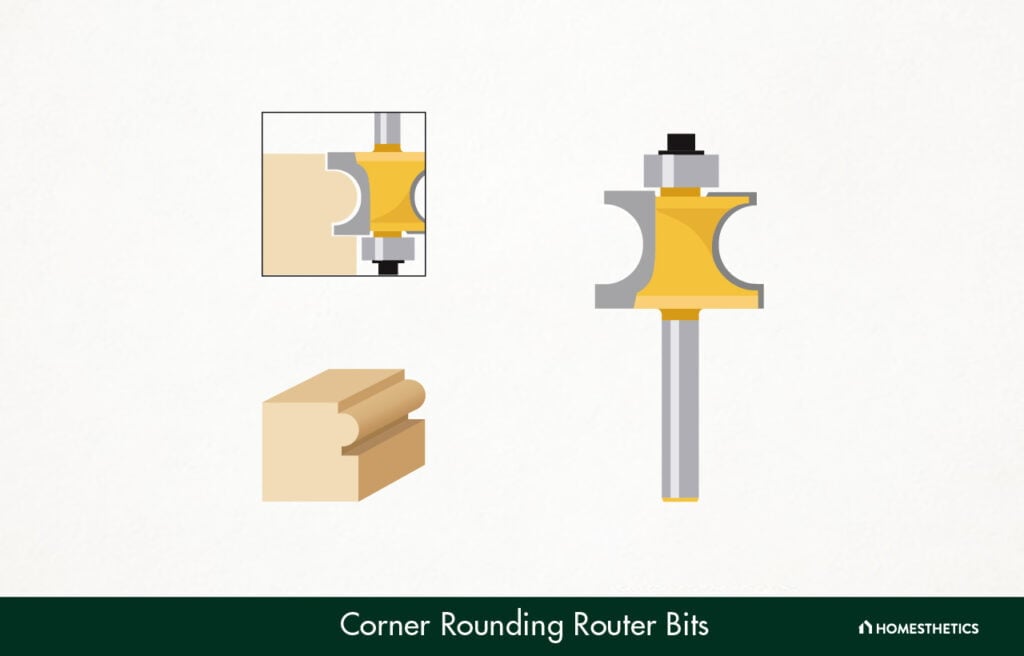
A corner rounding router bit is a cutting tool used in woodworking. It features a rounded cutting edge that creates smooth, curved corners on workpieces. As such, it is commonly used to round the sharp edges of boards, providing a visually appealing and safer finish.
44. Dado router bit
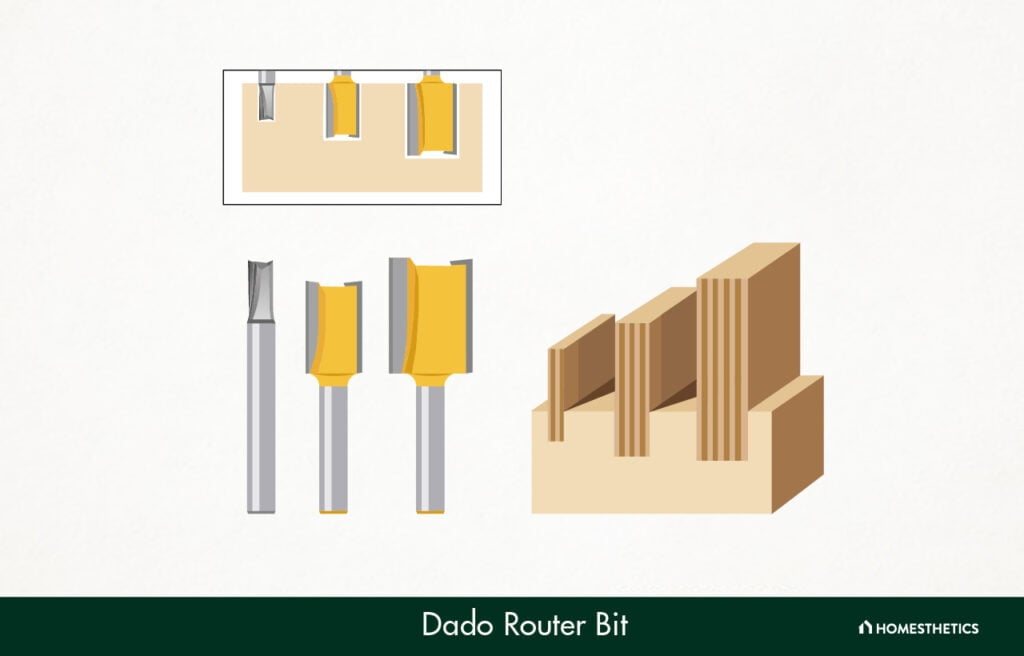
The bit is used to cut wide, flat-bottomed grooves or slots in wood or other materials. It creates a rectangular-shaped channel, allowing for precise and accurate joinery, such as making dado joints or housing joints for cabinetry or woodworking projects.
Jointing router bits
In the following section we will discuss miter lock bits, drawer lock bits, reversible glue joint bits, window sash bits, finger joint bits, stile and rail bits, reversible ogee bits, and box joint bits as specialized jointing router bits but please note versatile bits like lock rabbet bits, dovetail bits, biscuit joining bits, t-slot bits, half-blind dovetail bits, through dovetail bits, sliding dovetail bits, mortising bits can be used for jointing as well.
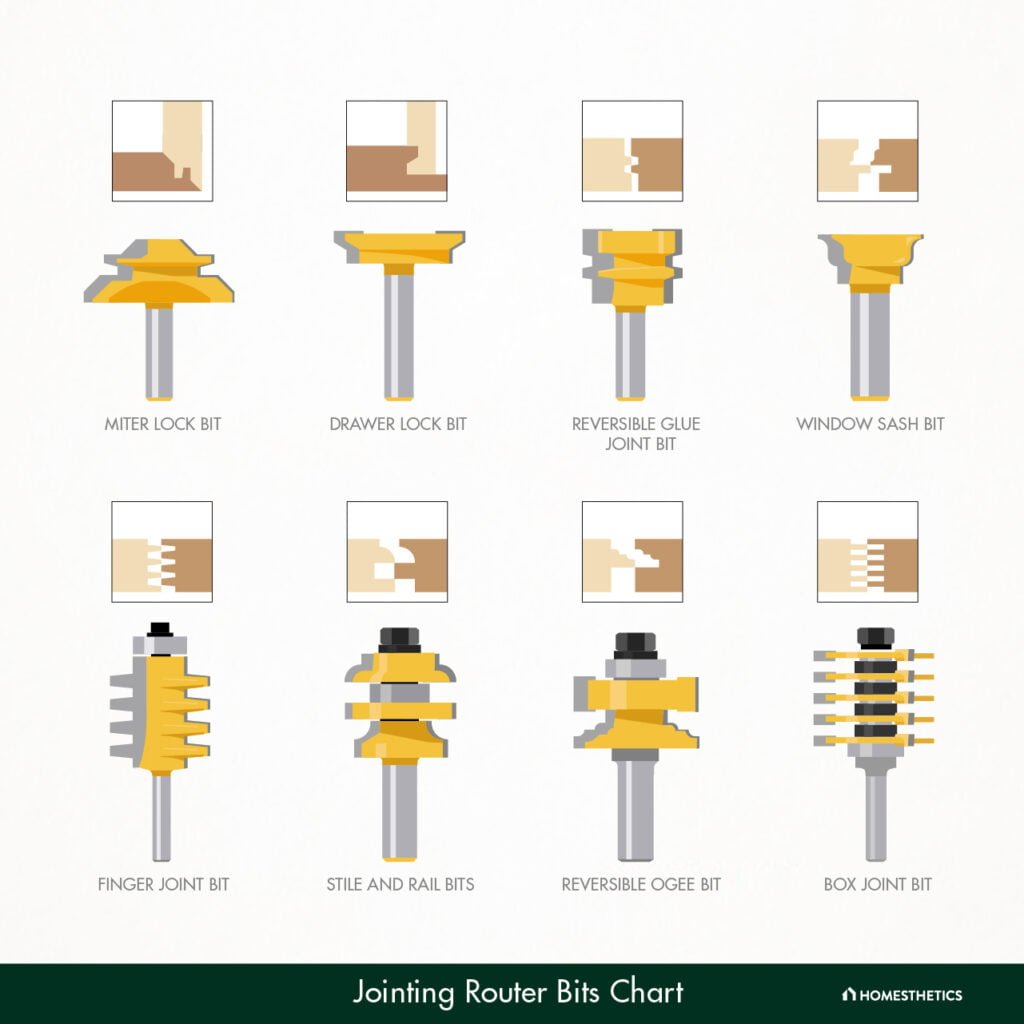
45. Miter lock router bit
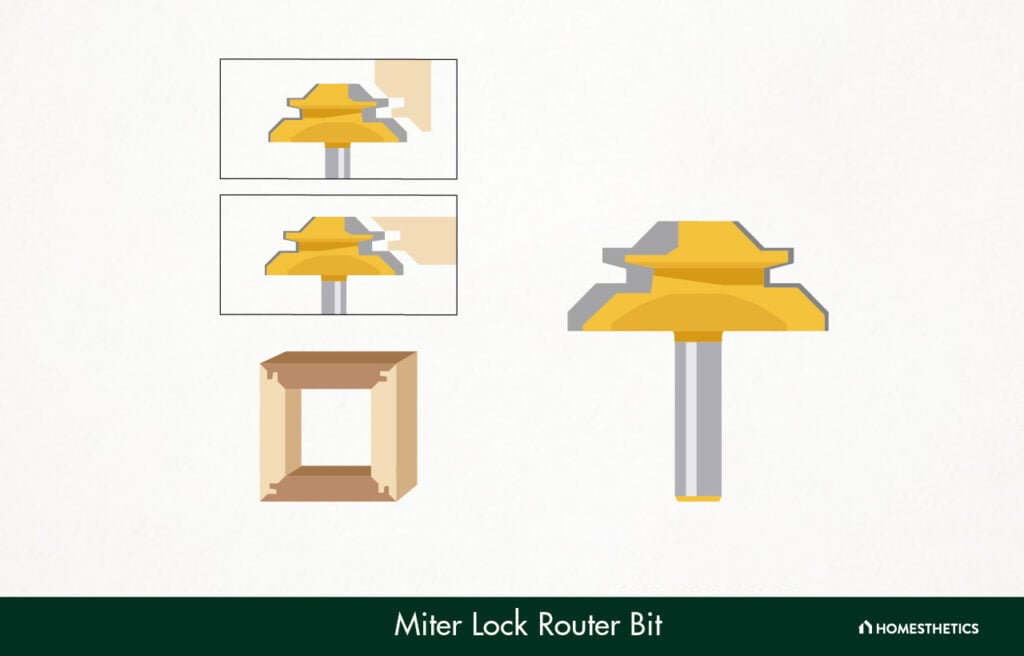
This bit is used to create strong and precise miter joints in woodworking. It forms a unique interlocking shape with angled edges that fit together seamlessly, ensuring a secure connection. The bit cuts both the mitered angle and a corresponding profile, resulting in a tight, durable joint.
46. Drawer lock router bit

A drawer lock router bit is used to create interlocking joints for drawer construction. It cuts a profile that combines a rabbet and a tongue, resulting in a strong and secure connection. The shape produced is a precisely fitting joint that holds the drawer parts firmly together.
47. Reversible glue joint router bit
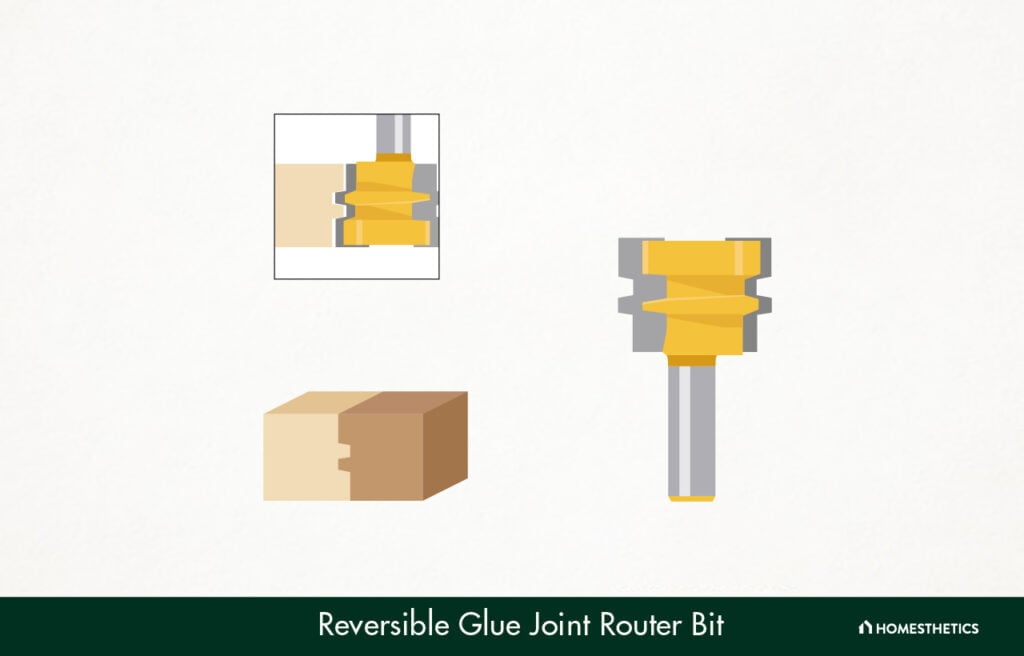
It is designed to create tight and strong glue joints between wood pieces. The bit produces a unique, interlocking shape, commonly known as a finger joint or box joint, where alternating fingers and slots align to create a secure bond when glued together.
48. Window sash router bit
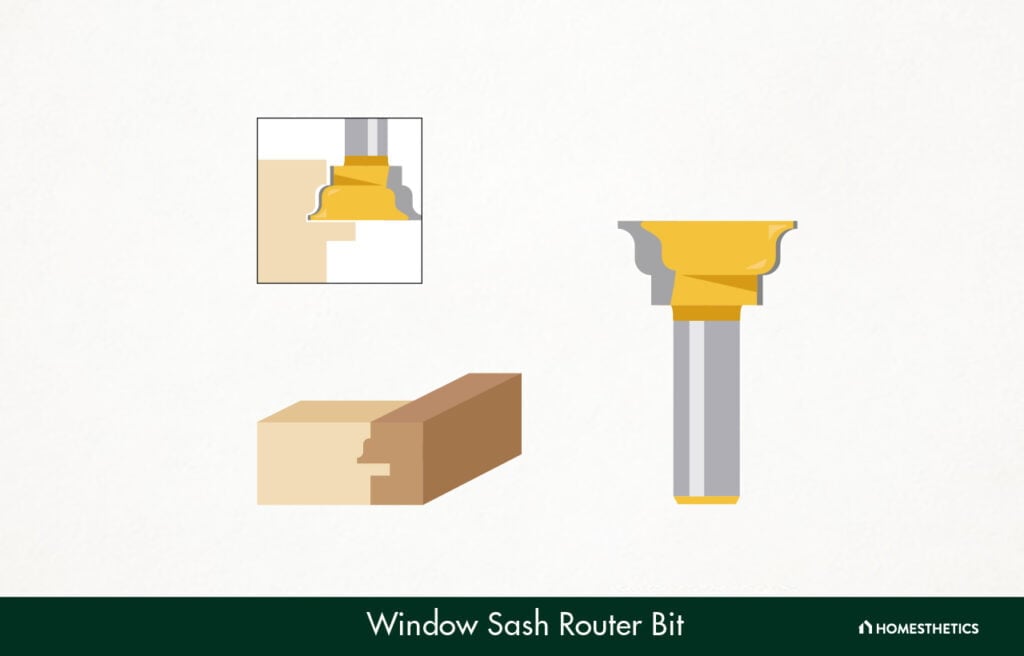
A window sash router bit is used to shape the profile of window sashes. It creates a groove along the edge of the sash, allowing the insertion of glass panes or panels. The resulting shape is a precise, clean groove that ensures a secure fit for the window component.
49. Finger joint router bit

A finger joint router bit is used to create strong and precise router joints in woodworking projects. It forms interlocking “fingers” along the edges of boards, allowing them to fit together tightly. The resulting joint enhances strength, stability, and aesthetics, used in cabinetry and box constructions.
50. Stile and rail bits
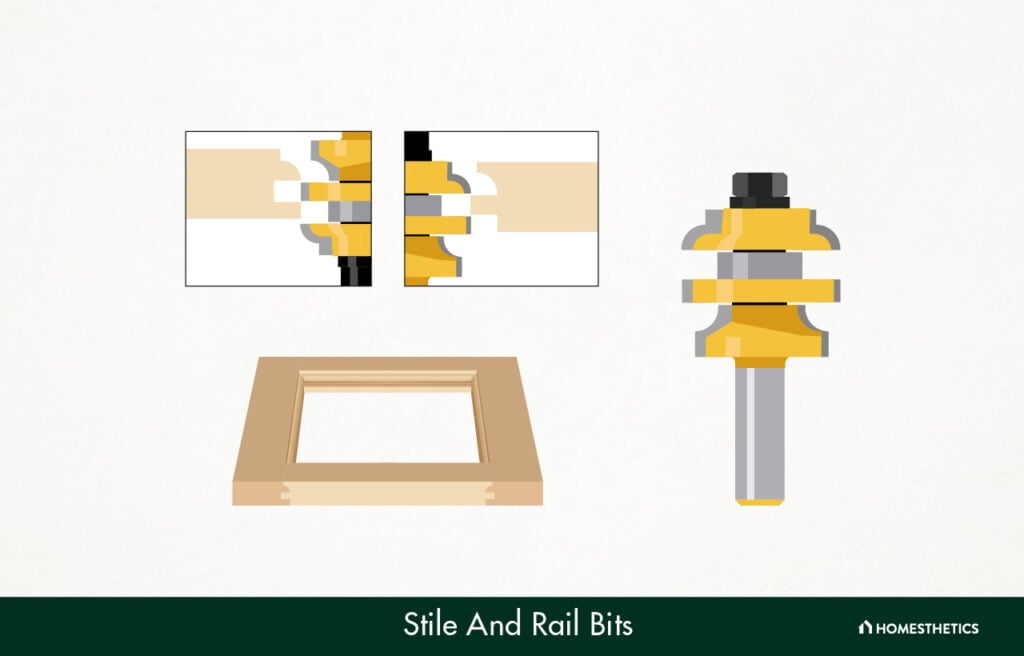
A stile and rail router bit is used to create the classic decorative joint in cabinet doors and panels. It forms a shaped profile along the edges, with a groove on one side (stile) and a matching raised profile on the other side (rail).
51. Reversible ogee router bit

It is a versatile woodworking tool that can create decorative edge profiles on wood. The bit produces an S-shaped profile with a concave curve followed by a convex curve. It can be used for various applications like creating elegant moldings and edging on furniture or cabinetry.
52. Box joint router bit
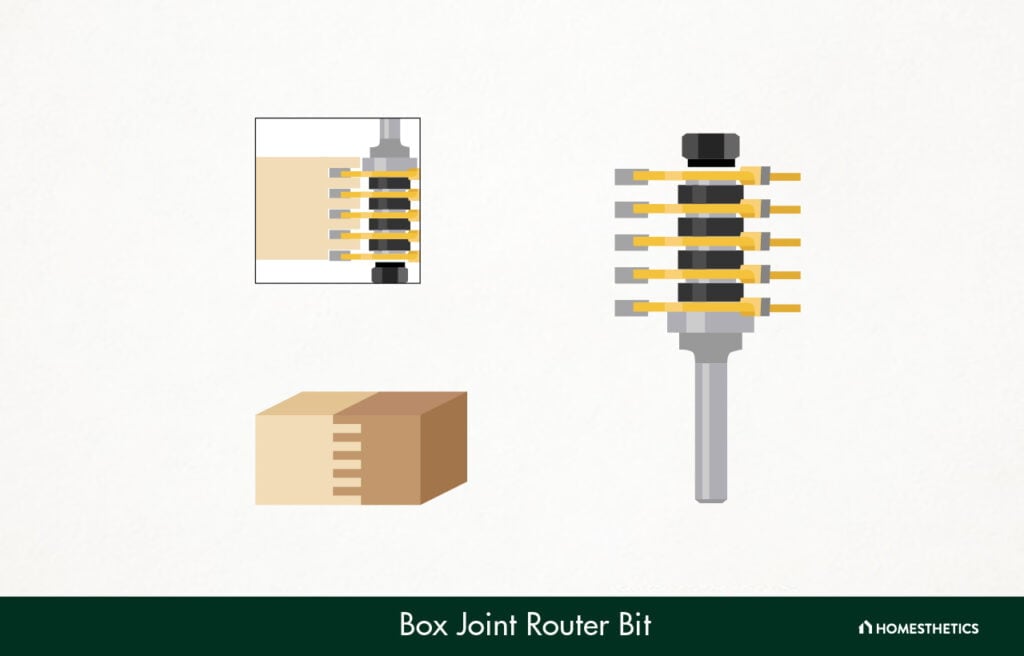
Box joint router bits are used in woodworking to create precise and interlocking joints. They produce square or rectangular cutouts with alternating fingers and spaces. These joints strengthen and stabilize assembled pieces for furniture construction and box-making projects.
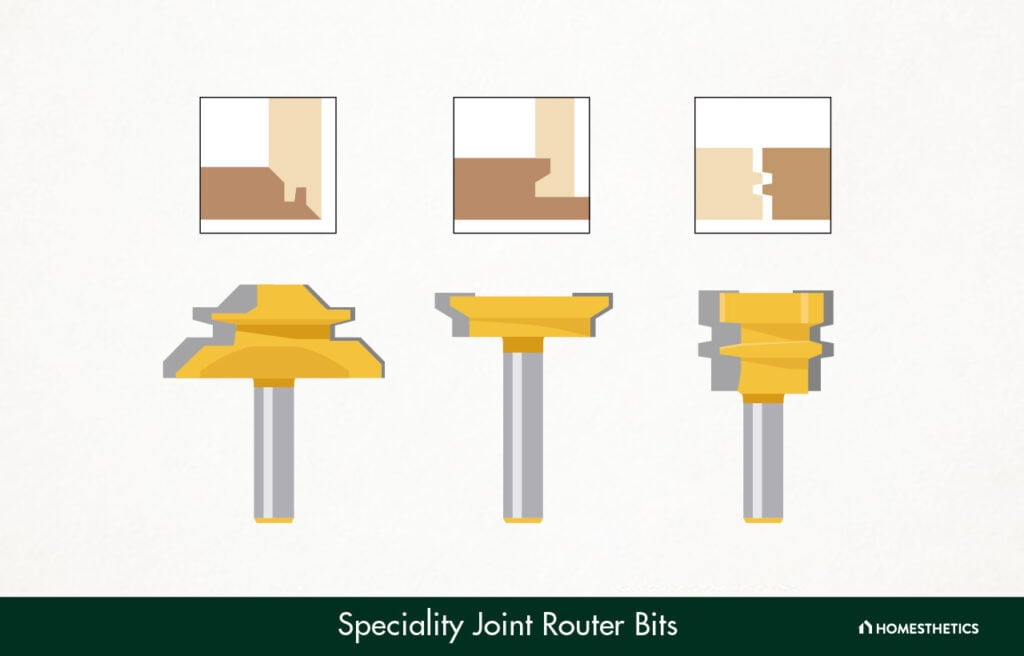
Warning: Router bits can cause severe injuries if mishandled. Always wear protective gear and use proper techniques to avoid accidents.
Router bits charts
In the following illustration, all the bits above have been exemplified in a piece of wood, showcasing the path sculpted by the router bit in a solid piece of wood while in the second router bit chart below you will find the exact 2D shape that a router bit creates into the section of the same wood.

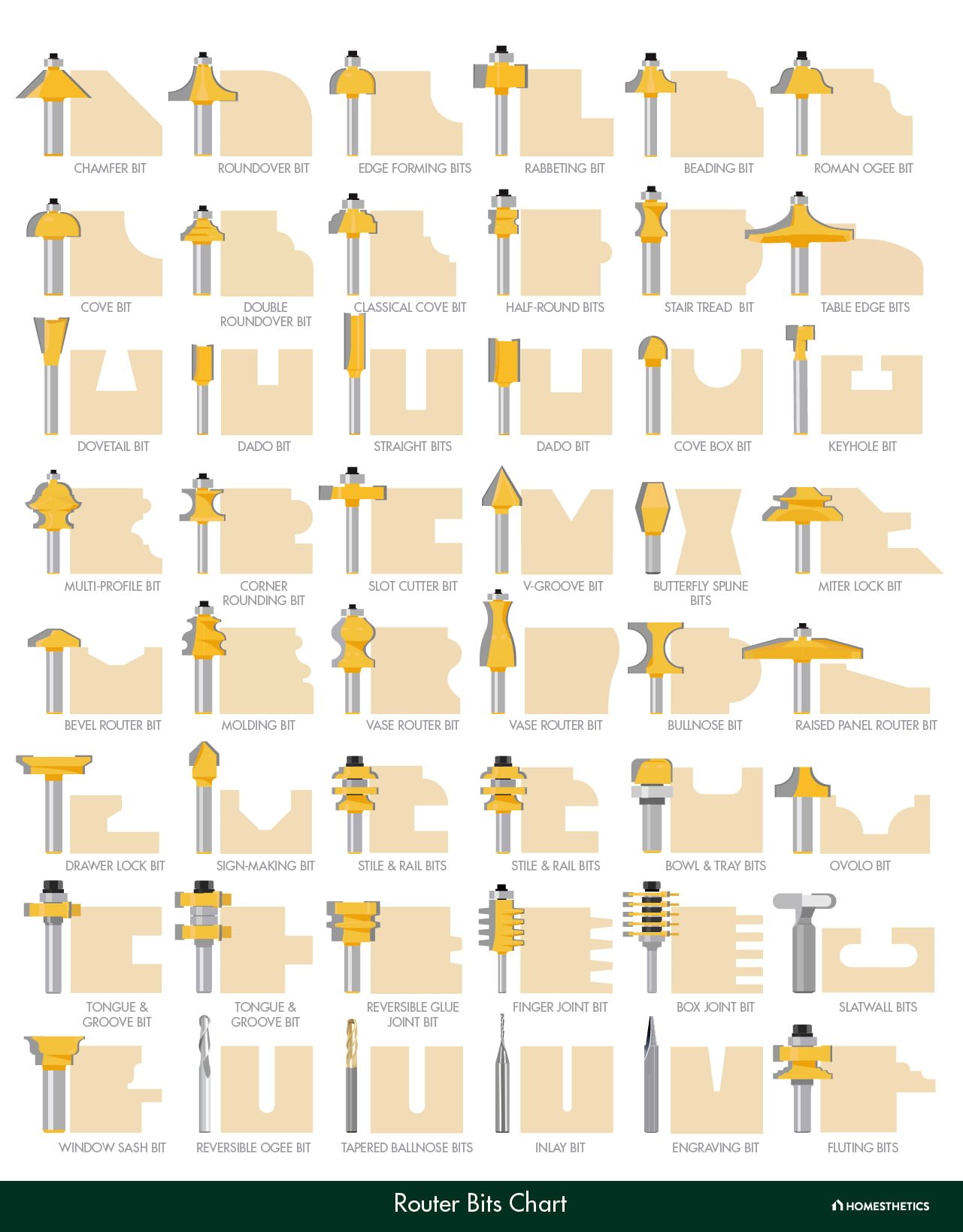
Are there router bits made from unconventional materials?
Yes, there are router bits made from unconventional materials like diamond, carbide, or even titanium–coated steel. These specialized materials offer enhanced durability, heat resistance, and cutting efficiency for specific applications.
Can router bits be customized for unique woodworking projects?
Yes, router bits can be customized for unique woodworking projects. Some manufacturers offer custom router bit services, allowing woodworkers to design bits tailored to their specific needs. This enables intricate and personalized woodworking creations that go beyond standard bit options.
Are there router bits designed specifically for non-wood materials?
Yes, there are router bits designed specifically for non-wood materials like plastic, acrylic, aluminum, and even glass. These specialized bits offer precise cutting, shaping, and engraving capabilities for diverse applications beyond traditional woodworking projects.
In the realm of routing, where wood meets art, three warriors step forth to claim their glory. Like a fearless knight, the straight router bit cuts paths with unwavering precision, carving straight grooves through wood. The flush trim router bit, on the contrary, effortlessly trims excess material, leaving a seamless finish. And then, there are the rabbeting router bits that help create recesses and grooves, creating space for joints and secrets to dwell.
Nonetheless, each type of router bit highlighted in this article possesses unique strengths. So, choose based on your woodworking requirements, and let the art of woodworking unfold with every plunge.
